The History of Oakwood Cemetery
Organized in 1848 at the height of the rural cemetery movement and now a National Historic Landmark, Oakwood Cemetery is both graveyard and garden and spreads over 280 acres of wooded parkland north and east of the City of Troy and the Village of Lansingburgh. As one of the most exceptional rural cemeteries in the United States, the grounds of Oakwood feature beautiful trails, several ponds, sculptures, and stonework. Oakwood commands views of the Hudson River Valley which serve as a spectacular backdrop to the history of its “residents.”
The rural cemetery movement was a response to the Puritan ethic of pre-determined destiny prevalent in the 17th, 18th and early 19th centuries in New England and Upstate New York. Early village and church burial grounds contained hundreds of marble or slate stones placed in straight rows and engraved with stern epitaphs promoting the notion that one’s place in heaven or hell was pre-determined.
As the 19th century progressed, towns grew to cities, and population increased proportionally. For reasons of public health and overcrowding, burial grounds began to be located outside of population centers and no longer on church grounds. There weren't public parks, art museums, or botanical gardens in American cities at this time.
Proponents of this new rural cemetery movement believed that people should be laid to rest in beautiful park-like settings, where ornamental plantings, beautiful fences, and sculptural gravestones reflected the deceased’s personality, their accomplishments on earth, and their expectation of glory in heaven. This landscape would ease the pain of bereaved relatives, who could be comforted by the thoughts of their loved ones being forever memorialized in a peaceful and scenic environment.
Designed with romantic vision based on English landscape gardening, rural cemeteries were consciously laid out to provide sanctuary, solitude, quiet, adornment, and beauty. It was common, especially on Sundays, for whole families to picnic in rural cemeteries “taking long walks in the peaceful setting, thinking about the past and the future, and keeping a little bit of history alive for themselves.” (Source: Forest Hill Cemetery Committee of Historic Madison, Inc. A Biographical Guide to Forest Hill Cemetery)
The rural cemetery movement followed closely on the heels of the optimistic religious revival movements of the 1830s and the writings of American authors such as Thoreau, Hawthorne and Emerson. Artists commissioned to create tombstones as sculptures embraced cemeteries as settings for public display of their work. In fact, the rural cemetery movement laid the groundwork for grand public parks such as Central Park in New York City and the development of American landscape architecture.
By the mid-1840s, the City of Troy had developed from a commercially based town along the banks of the Hudson River to an increasingly industrial city. Troy’s population rapidly increased due to the demand for labor in the iron and bell factories of South Troy and the burgeoning collar and cuff industry north of the downtown area of the city. Industrialists and entrepreneurs formed a growing and substantial upper class, willing to patronize art, libraries, civic improvements like orphanages and hospitals, and a rural cemetery.
Troy’s first burial ground was established in 1796. Located on the corner of Third and State Streets, portions of that burial ground were given to the First Baptist Church and the Quaker Meeting House for use by those respective congregations. Two other burial grounds, the Troy Cemetery located on the southeast slope of Mount Ida (now Prospect Park) and the Mount Ida Cemetery on Pawling Avenue, rounded out the principal non-sectarian city burial grounds. The Rev. Peter Havermans, founder of the earliest Catholic parishes, established Catholic burial grounds by the 1860s. Two Jewish burial grounds were established on the eastern outskirts of the city in the last quarter of the 19th century.
By September 1848, when land was purchased by the Troy Cemetery Association purchased for Oakwood Cemetery, Troy and Lansingburgh had an established upper class with sophisticated taste and a burgeoning middle class ready to spend money on purchasing family “plots.”
Cemetery trustees selected a site comprising 150 acres of land just north of Troy and east of the Village of Lansingburgh on an escarpment with views of the foothills of the Adirondacks to the north, the Cohoes Falls to the west and the Helderberg Mountains and Hudson River Valley to the south. They commissioned Philadelphia landscape engineer J. C. Sydney to lay out the curvilinear roads, plots and plantings. Sydney utilized the abundance of natural water sources to create the many ponds and waterfalls that enhance the landscape of Oakwood.
In 1871 the Troy Cemetery Association purchased an additional 150 acres adjoining the original property. Landscape architect John Boetcher introduced a wide variety of rare shrubs and plants, many of which survive today, to the Oakwood landscape.
Many of Troy’s wealthier families purchased plots in strategic locations commanding some of the finest views in the cemetery, hiring architects and artists to design and build their family mausoleums and sculptures to enhance the final resting place of their family members. Hundreds of remains were also re-interred from old Troy Cemetery on Mount Ida and the old burial ground on Third Street, which by 1875 became the site of Troy’s first City Hall.
The Jewel of Oakwood and a National Historic Landmark
A stunning example of Romanesque architecture, the Gardner Earl Memorial Chapel is Oakwood Cemetery’s most significant structure. Its opulence fosters a great understanding of Troy’s prominence during the Industrial Revolution and Gilded Age. Opened in 1890, this gorgeous edifice celebrates the Victorian notion of grandeur in death—and offers a window onto the extraordinary affluence of a select few.
The chapel’s namesake, Gardner Earl, was the son of a wealthy Troy collar maker who died young and left a request that he be cremated. Cremation as a form of final disposition was then nearly unknown in the United States, though it was popular in Europe, where Earl had learned of it during his travels.
After taking their son’s body to Buffalo to be cremated, the Earls decided to build the historic chapel and crematorium in his memory, sparing no expense. They gave well-known Albany architect Albert Fuller a free hand to design the chapel. They asked him to make the attached crematory building modern, artistically beautiful, and enduringly strong.
The Chapel’s exterior is faced with pink-tinted Westerly granite. A loggia of three massive arches connects the chapel with its towers, which provides a magnificent 100-mile view of the Hudson River Valley. The sumptuous interior, virtually unchanged in its 120 years, features eight Tiffany stained-glass windows. Marble mosaics in delicate tints adorn the floor and altars. Wainscoting is crafted of pink African marble. The ceilings and pews are all hand-carved quarter-sawn oak.
The reception room features two breathtaking Maitland Armstrong stained glass windows. The walls are covered with Siena marble from Italy, and the lower walls covered in marble mosaics. Columns are cut from green Brazilian onyx.
The Earl Chapel and Crematorium has been designated a National Historic Landmark and is listed in its own right on the National Register of Historic Places.
Today, the Gardner Earl Chapel at Oakwood Cemetery is a vibrant part of the Capital Region community, serving as the focal point and starting gate for all of Oakwood’s activities. Visits to the chapel are available by appointment. Please contact us to schedule a tour or to find out more about holding a memorial, wedding or other special event at “The Earl.”
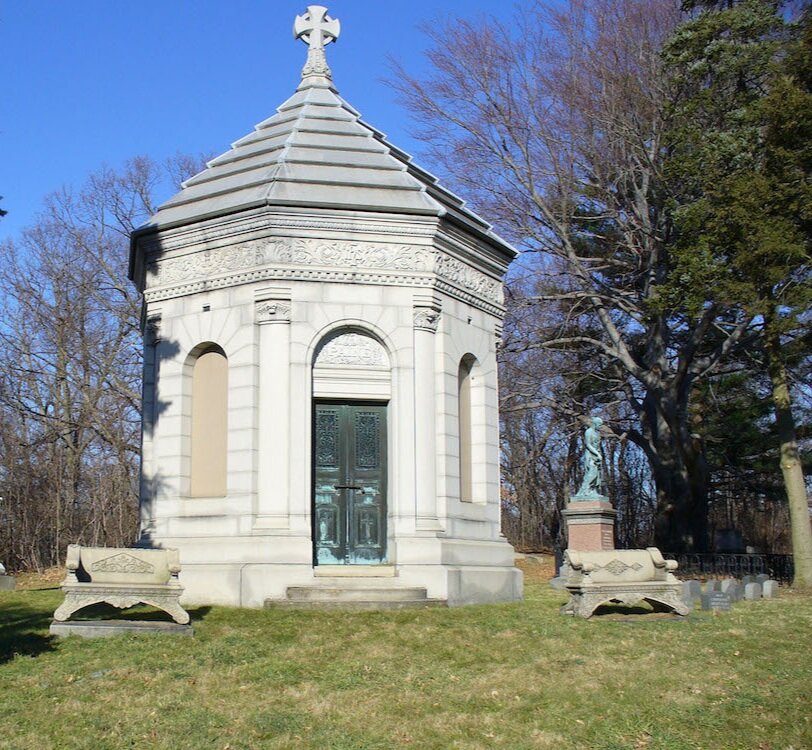
Who Is Buried in Oakwood?
Oakwood is the final home of many founders and leaders of communities in Upstate New York, including at least 14 members of the U.S. House of Representatives, all hailing from New York State. It is also home to military servicemembers who have fought in every U.S. conflict.
The founders of Troy and Lansingburgh, Jacob D. Vanderheyden and Abraham Jacob Lansing respectively, were both re-interred at Oakwood, having been moved there from downtown Troy in 1869. Some of education's finest teachers are also buried there, including Amos Eaton, a well-known botanist and geologist and founder of Rensselaer Polytechnic Institute; Mary Warren, founder of America's first educational institution for "problem children"; Emma Willard, pioneer of women's education and founder of the Troy Female Seminary, which was later renamed Emma Willard School in her honor; and David Hillhouse Buel, a president of Georgetown University.
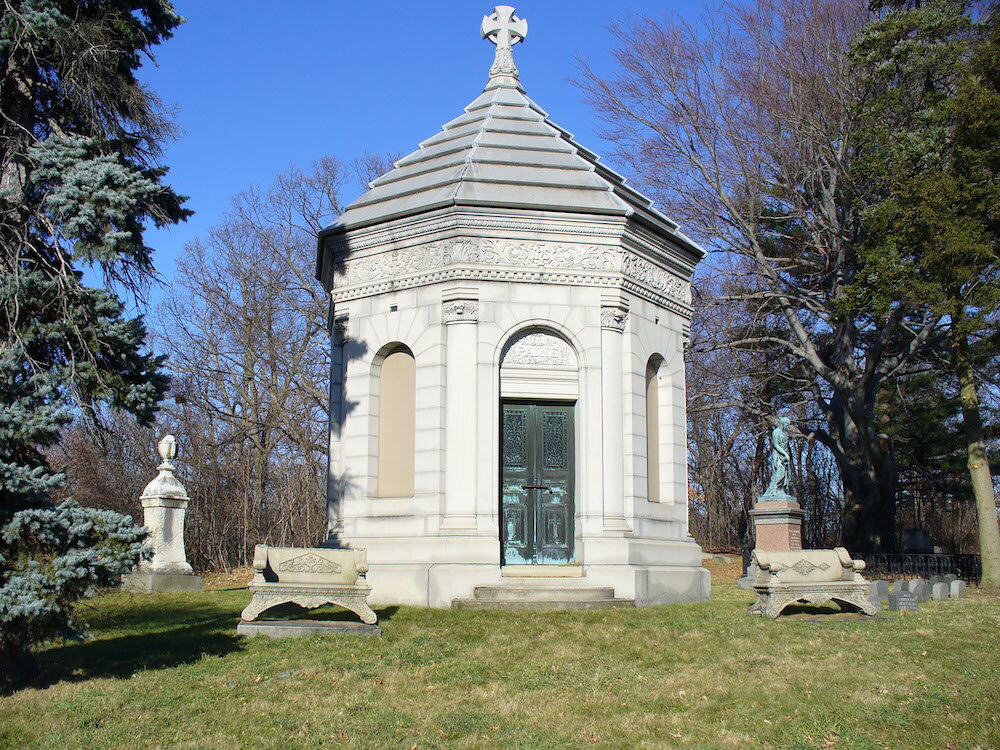
Burial place of John Paine.
You’ll notice boarded up stained glass windows which are too fragile to see. The one we can see is marvelous, and it appears to be English. The banner reads, “I am he that liveth and was dead / and behold I am alive for Evermore.” Revelations 1:18, King James Version.
Over the door is the Motto “Toujours Pane.”
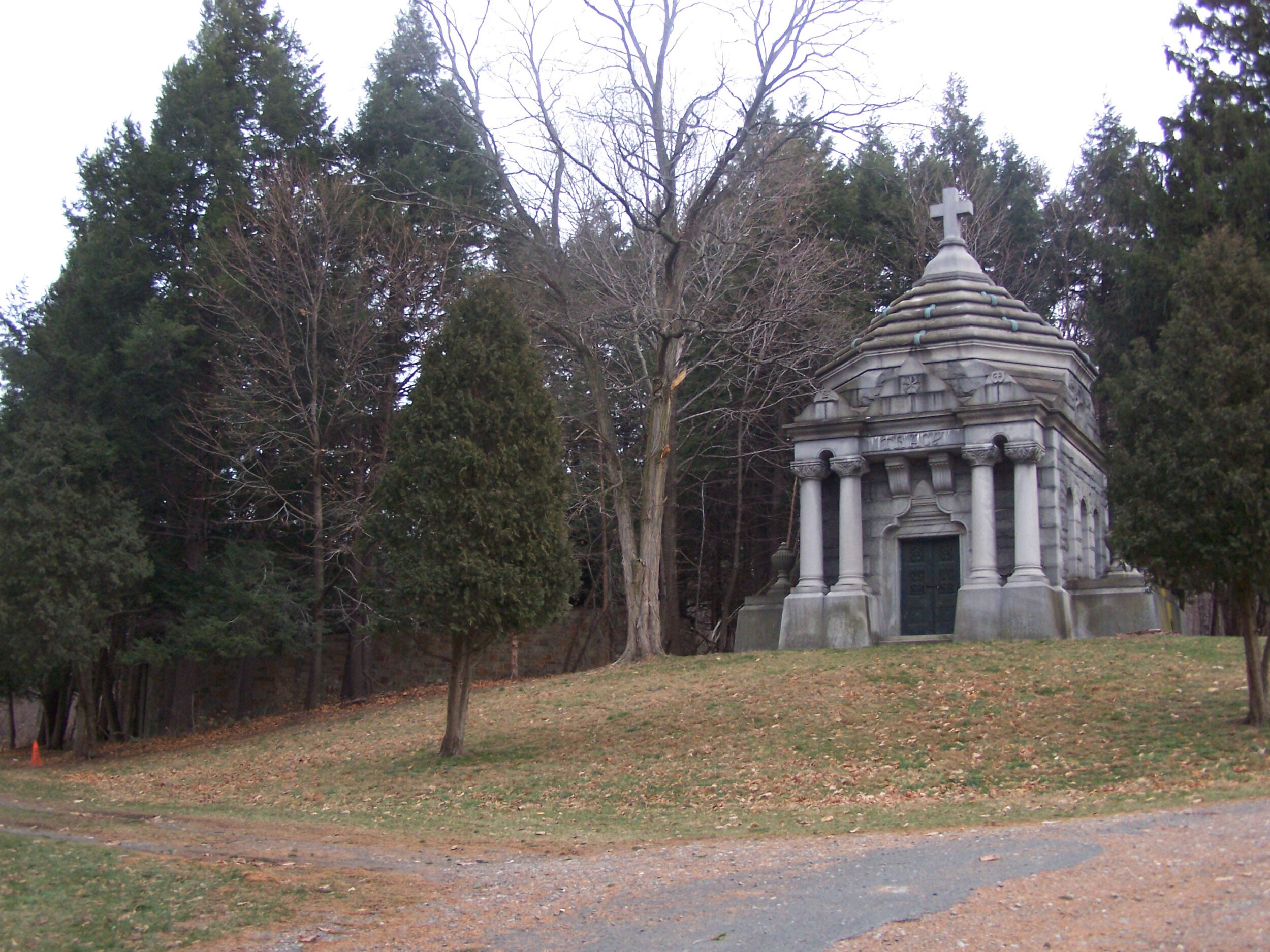
Burial place of the Tracy family, including Edward Tracy whose sister Sara Catherine Aloysia Tracy constructed the mausoleum for her brother upon his death.
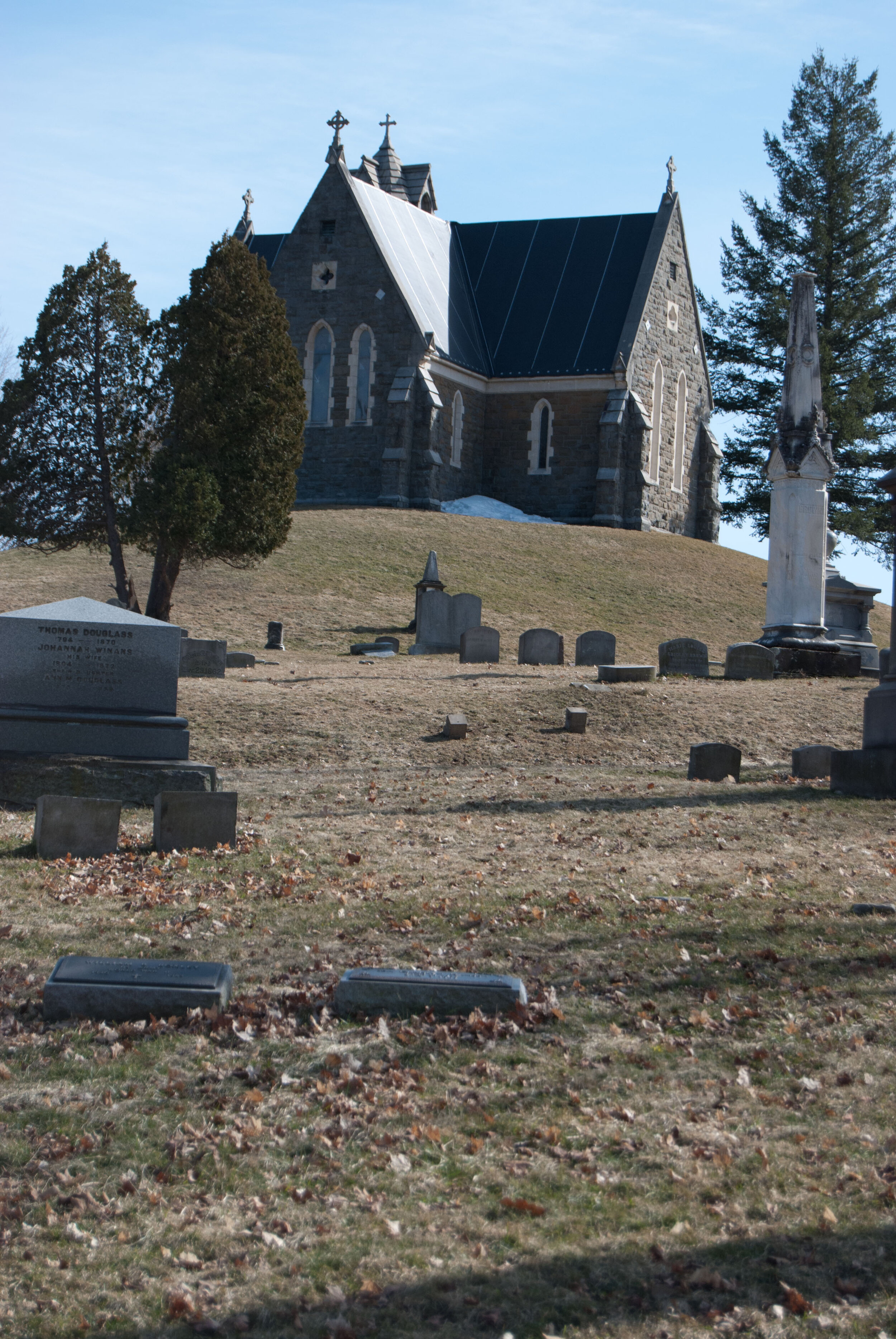
The Warren Chapel was designed in the English Gothic Revival Style by noted New York architect Henry C. Dudley in 1861. A later addition of a bell tower was also designed by Dudley in 1883. The building is the next-largest chapel and mausoleum in Oakwood after the Earl Chapel and Crematorium.
The family vaults lie beneath the floor of the chapel. The Warren family settled in Troy in the 1700s, first engaging in the mercantile trade before engaging in the stove and hardware foundries that made Troy famous in the 19th and early 20th centuries.
Among those buried here is Joseph Mabbett Warren.
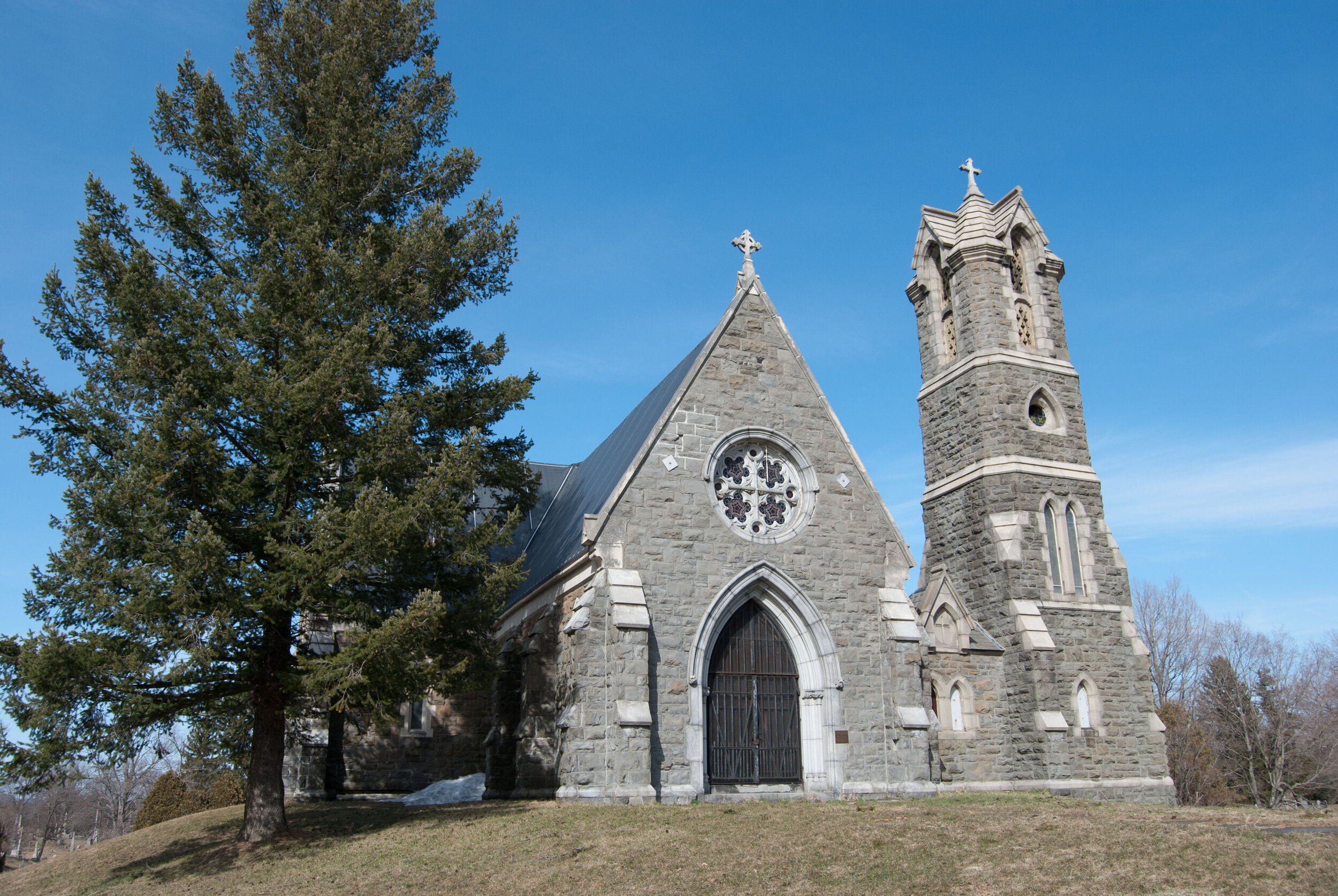
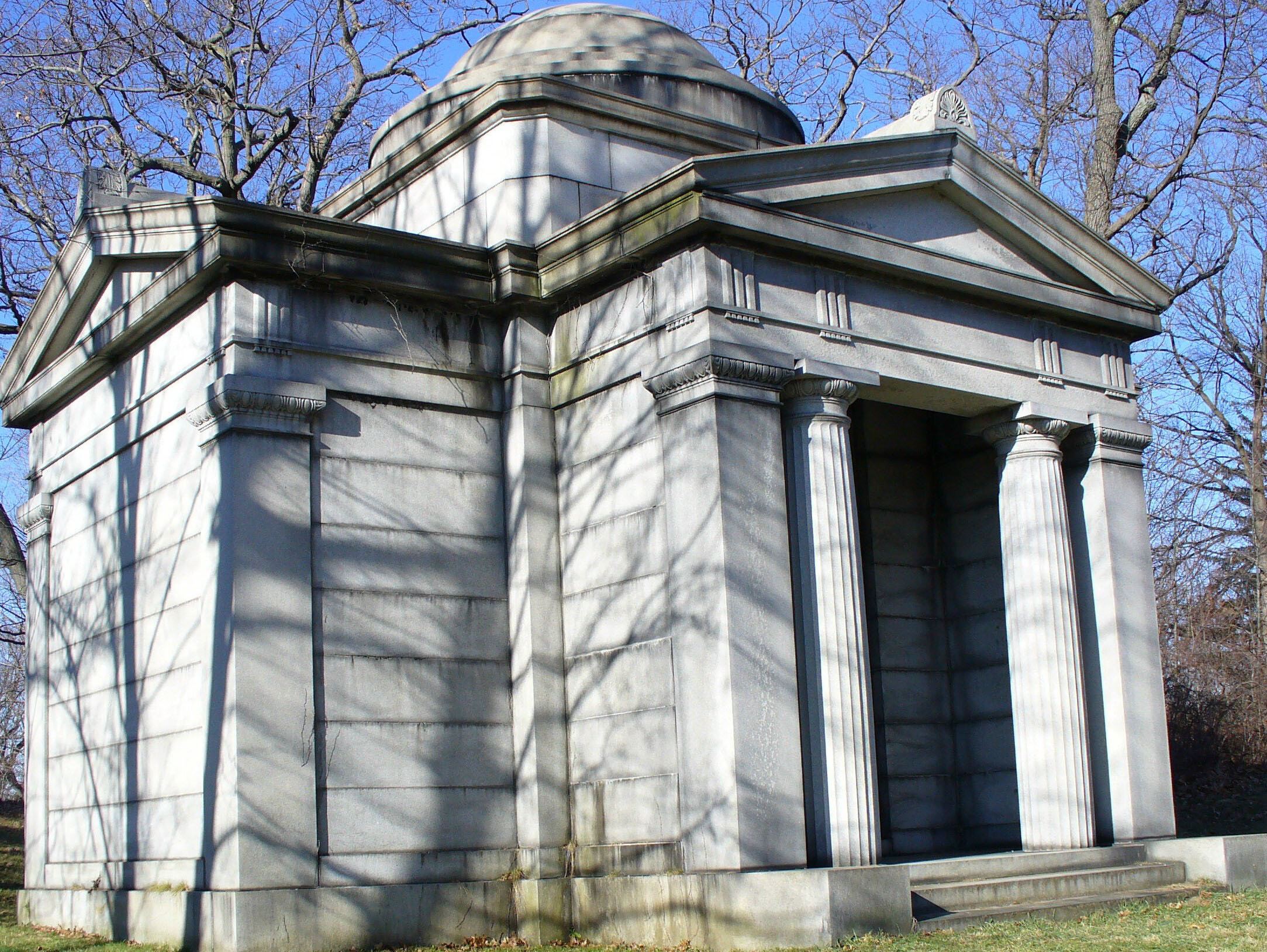
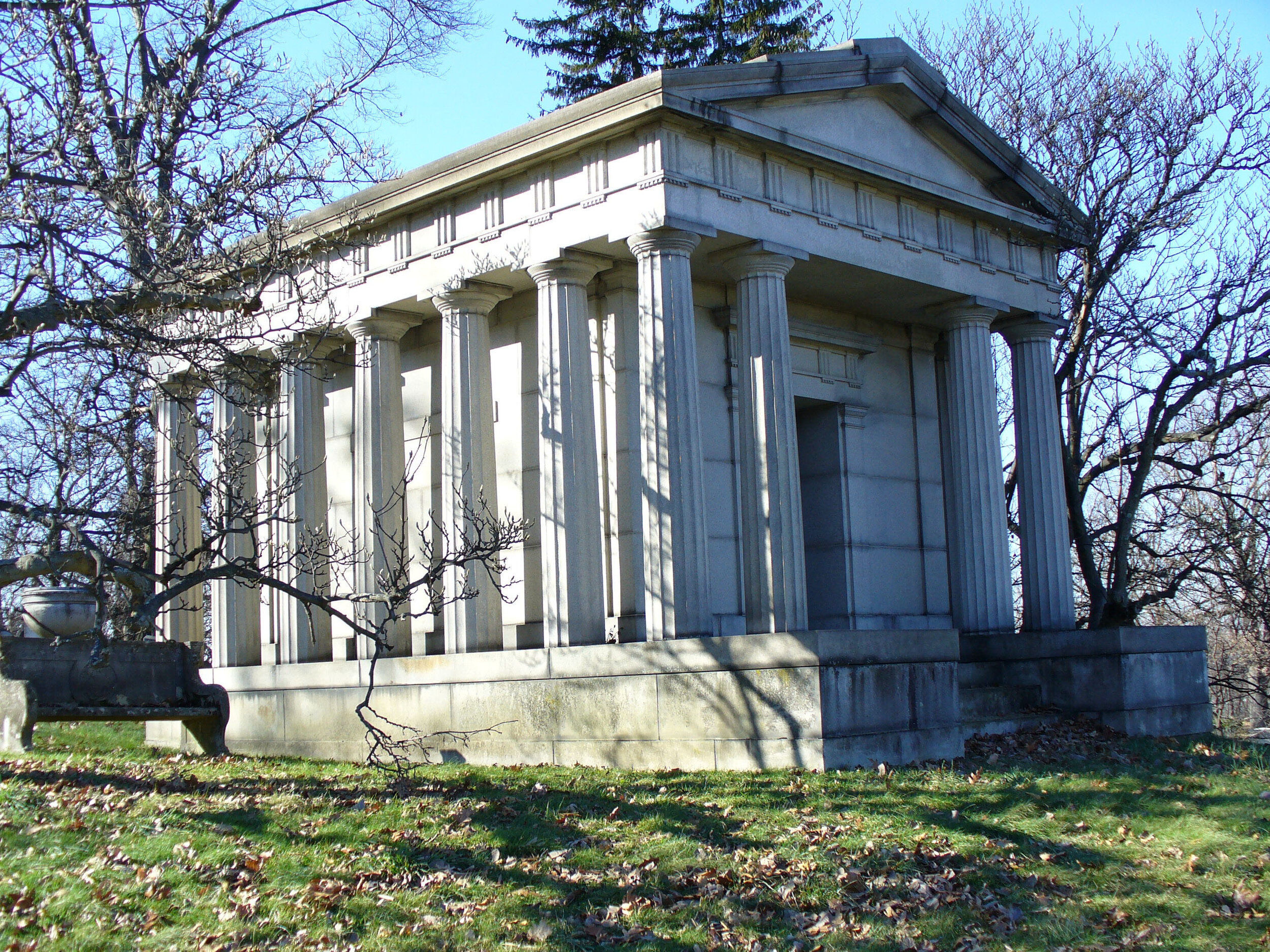
Burial location of Russell Sage, this mausoleum is a wonderful tiny Greek Temple, and left deliberately unmarked.
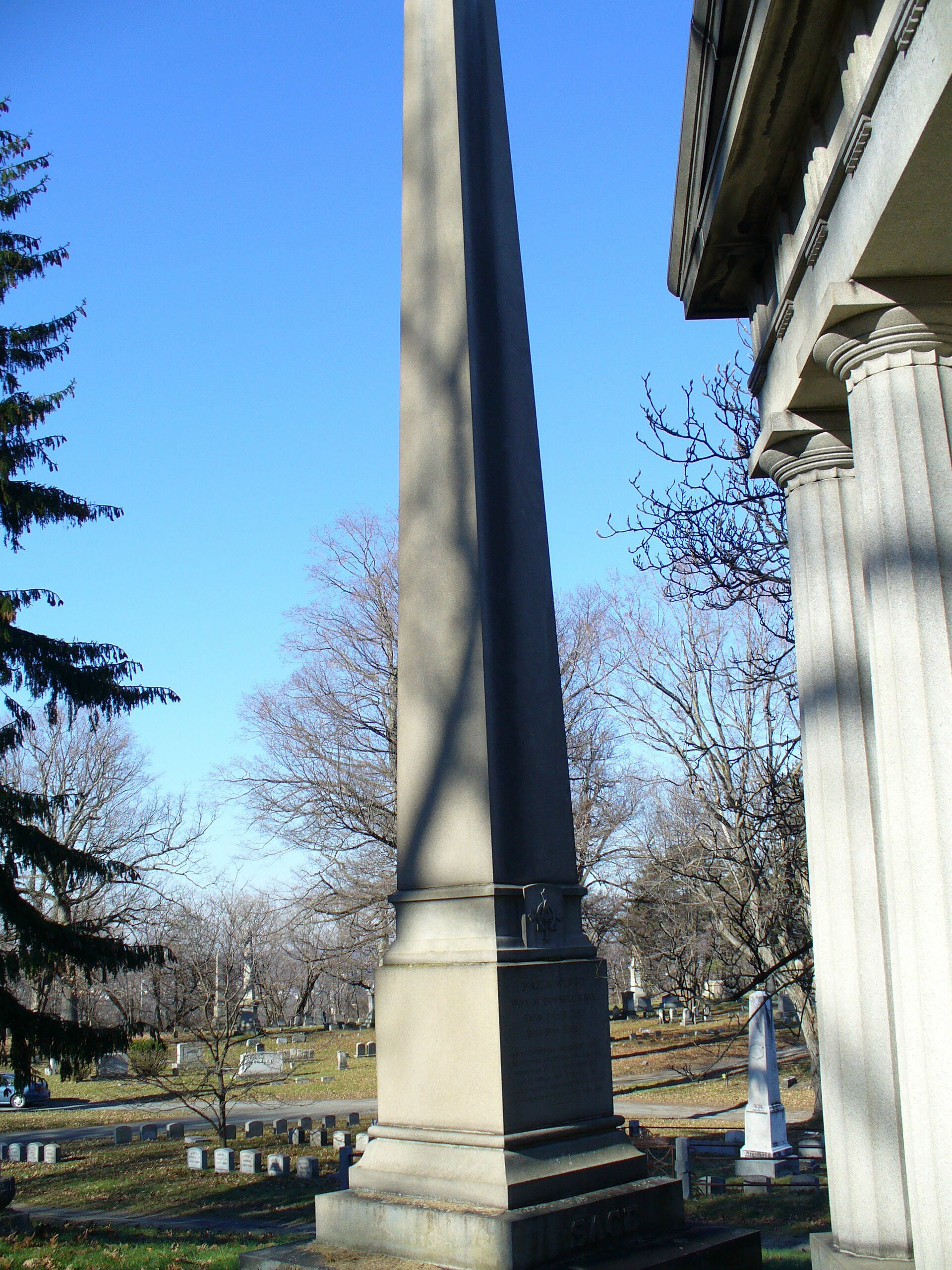
This is the burial site of the first wife of Russell Sage. It is located next to the Sage Mausoleum.
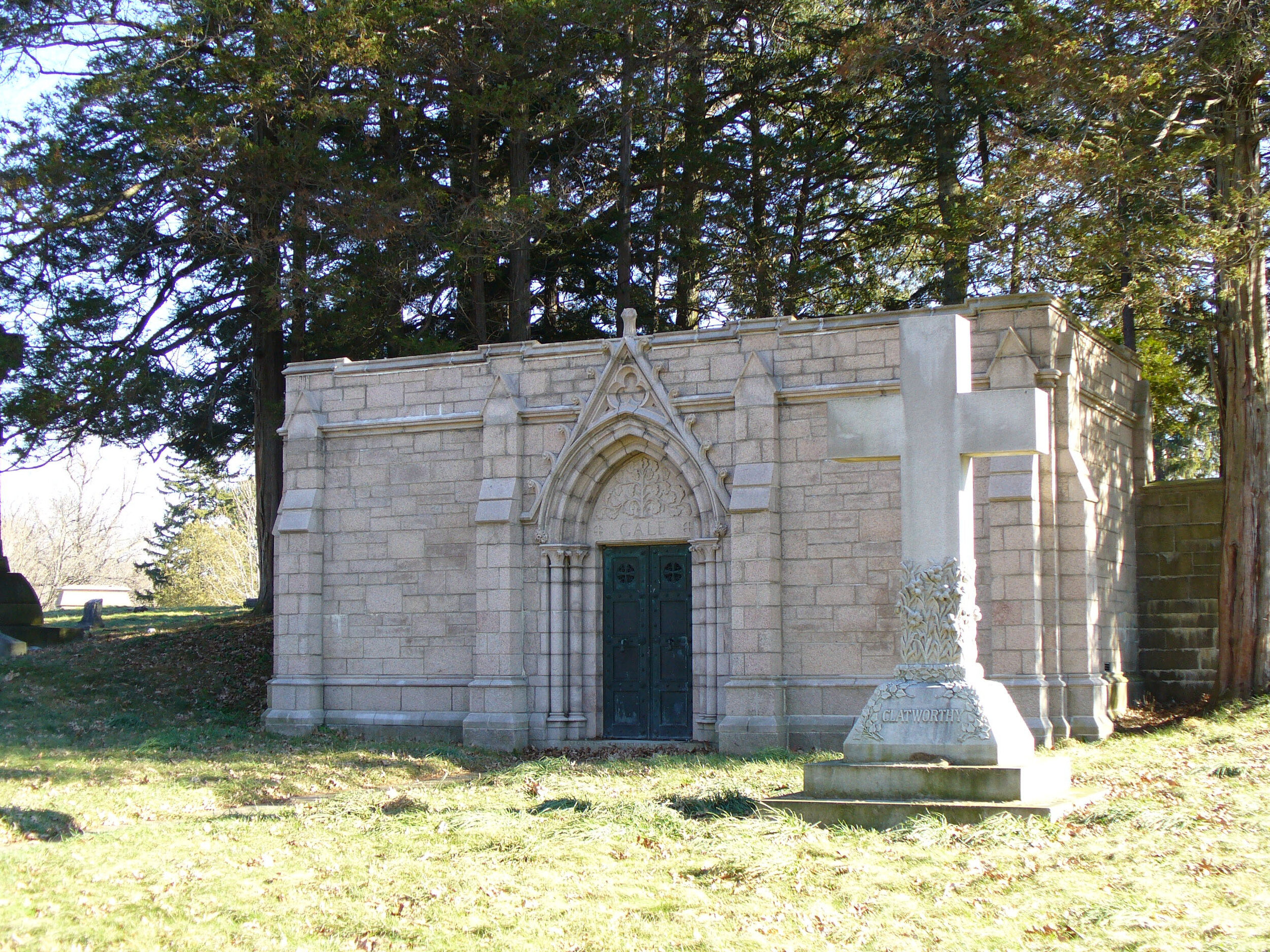
Gayle Mausoleum is a simple expression of the Gothic Revival. The architect was Ralph Adams Cram, who designed the Chapel at West Point and many more, including St. John the Divine in NY City, Princeton Chapel, and the American Church in Paris.
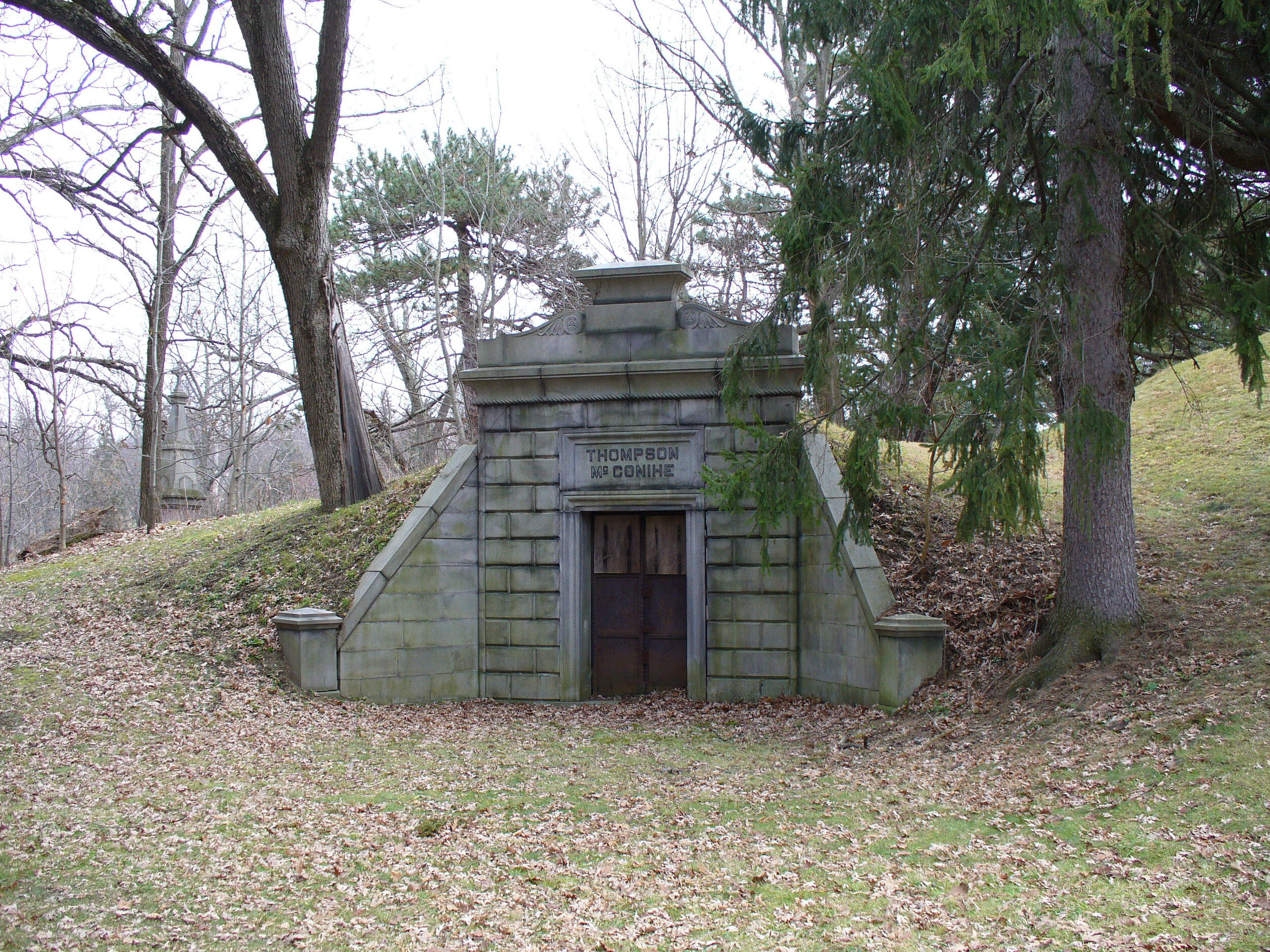
Buried within is John McConihe.
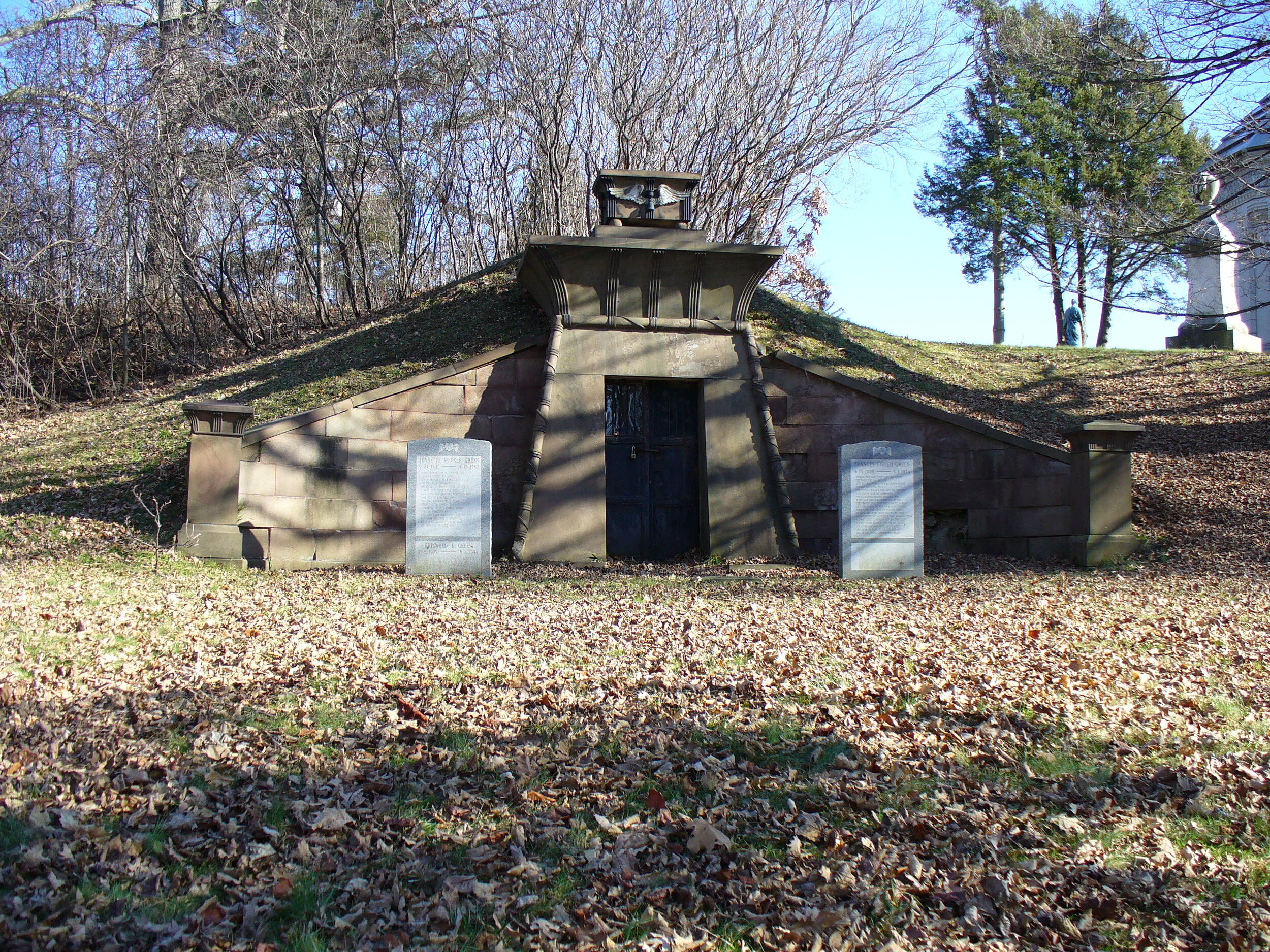
The Greene Mausoleum was constructed in an Egyptian Revival Style.
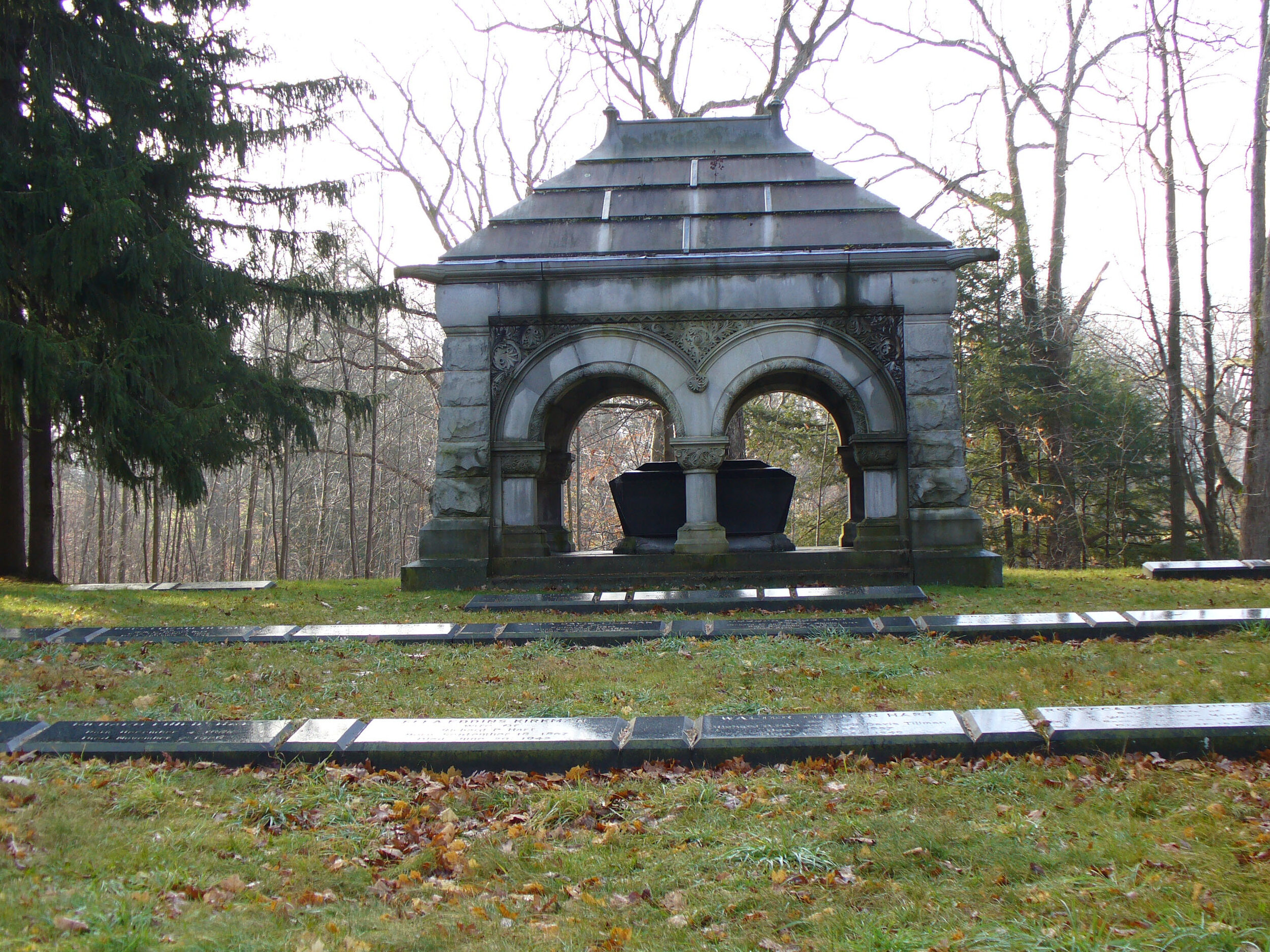
Among those interred here is former Troy mayor Richard Philip Hart.
The structure has inscriptions at either end, one saying Hart, the other Howard. Many Cluetts are also represented in the series of tombstones in front. The Harts had been buried in Mount Ida Cemetery, but Mrs. Betsy (nee Howard) Hart brought them all to Oakwood. She built this structure in 1885.
The architecture here is strongly influenced by Henry Hobson Richardson. The rusticated stone work, the enormous semi-circular arches and the short solid columns are characteristic of Richardson’s work, which was very influential in the Capital District. Richardson was the first American Architect perceived nationally and in Europe as doing original work in an American style, which came to be called Richardsonian Romanesque. He was well known and influential all across the US, and particularly in the Capital District. He was one of the Architects of the State Capitol, where his office designed the senate side, including the senate chamber, and Albany City Hall.
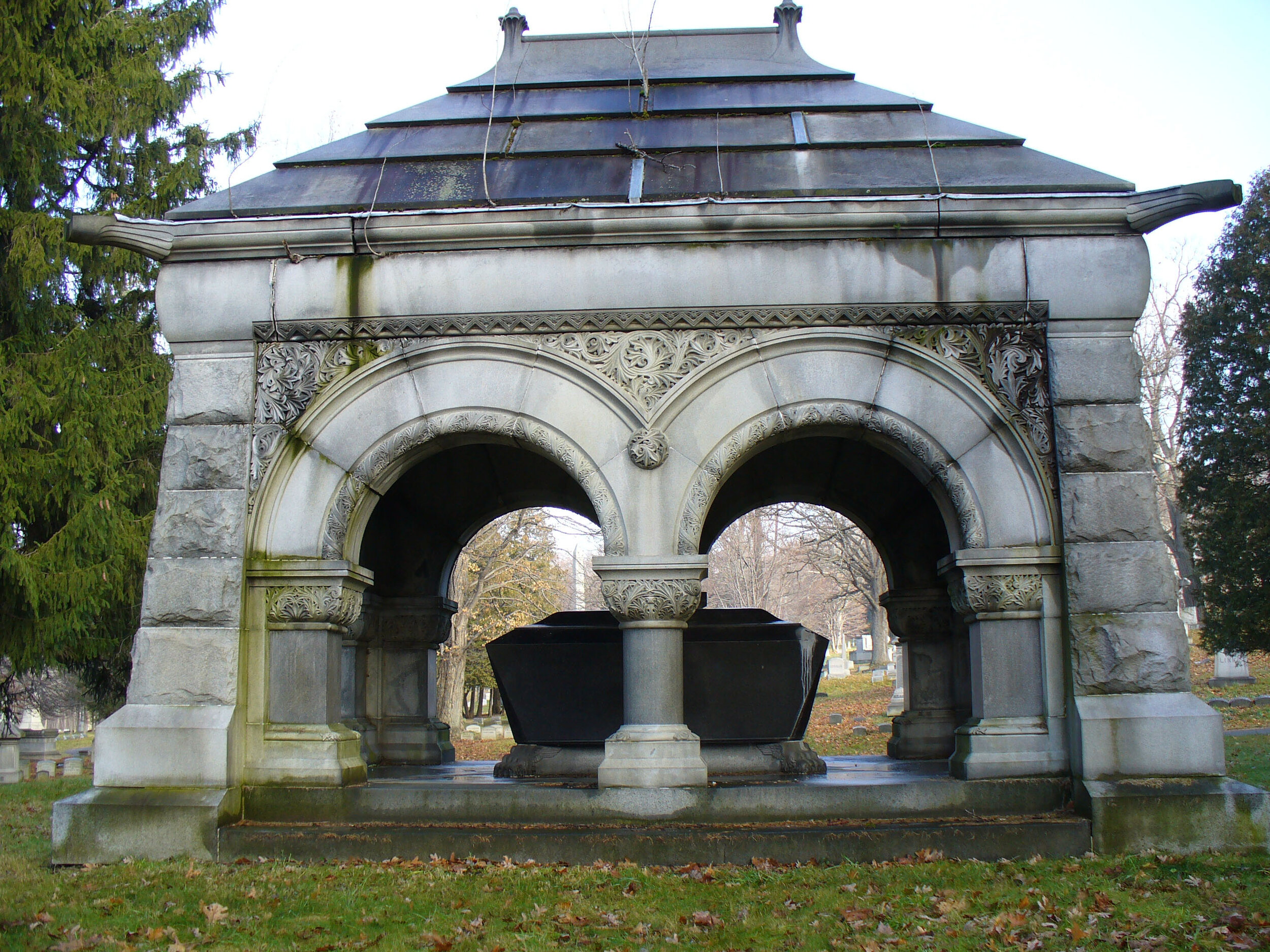
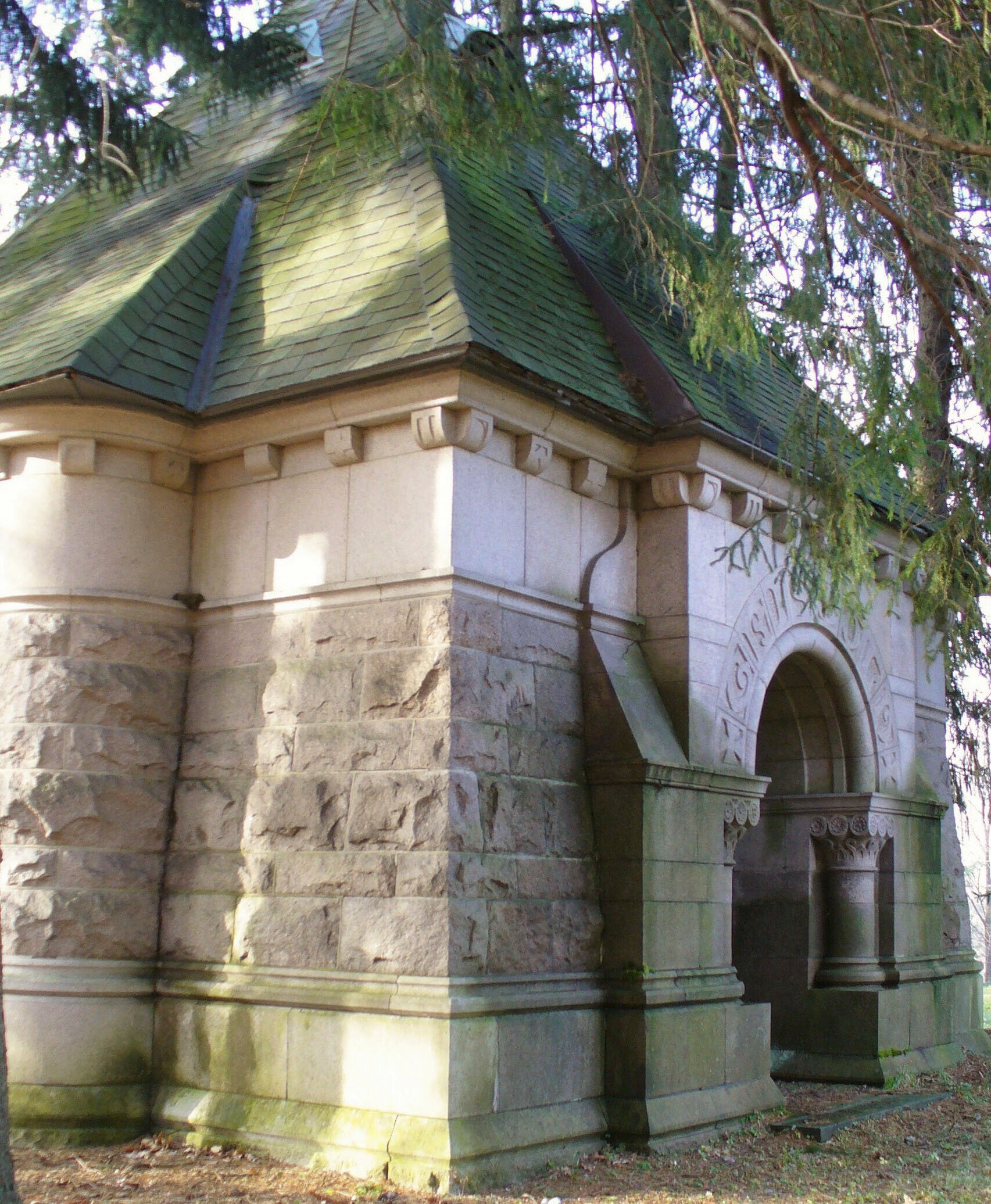
Burial site of John Augustus Griswold. The Griswold Mausoleum features a pyramidal roof, and a cross on the top, just above the dormer.
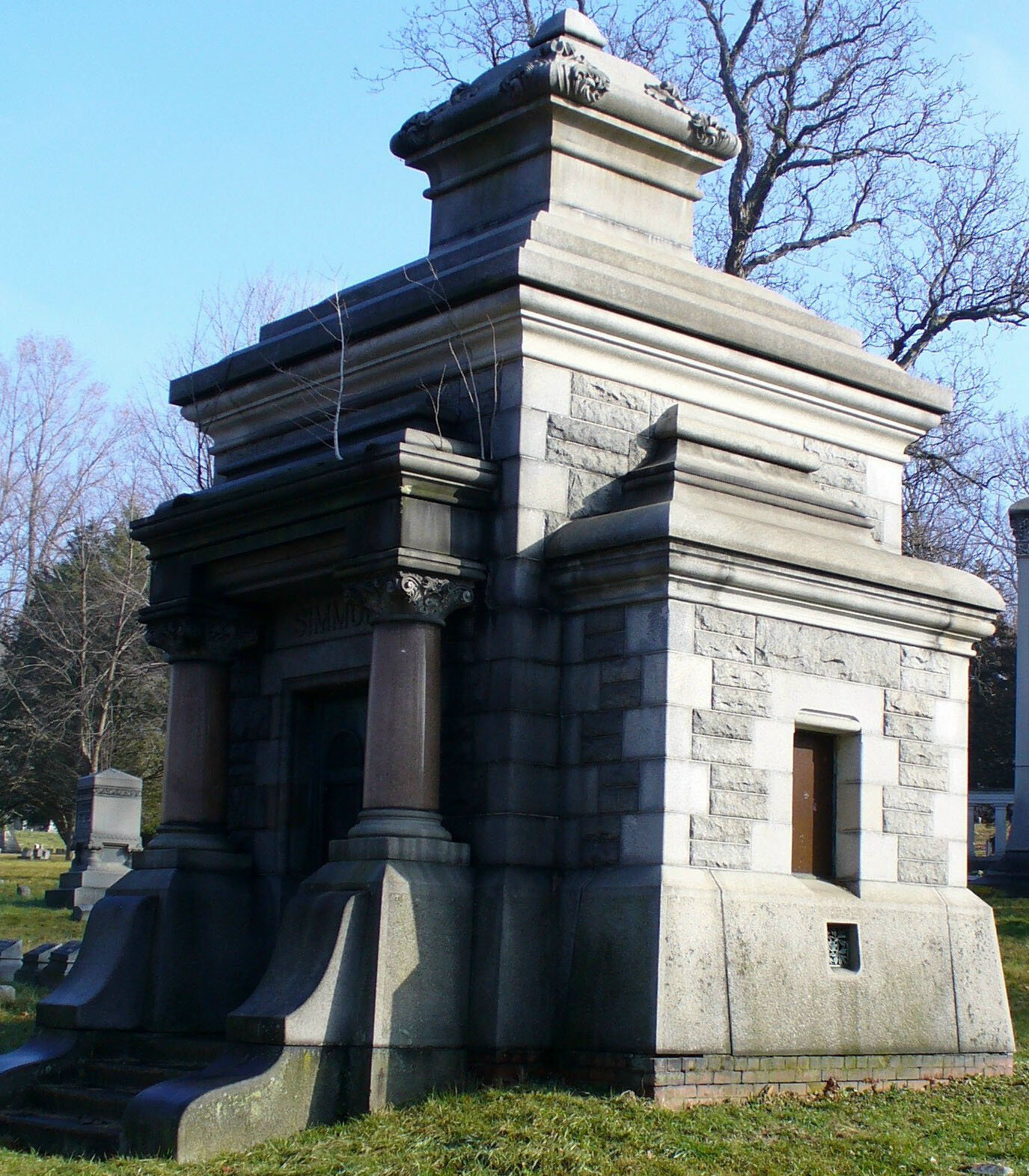
The Kemp Mausoleum, built in 1898, once held a Tiffany window, “Angel of Resurrection.” William Kemp had a brass foundry and is a former Mayor of Troy. Like many others, the mausoleum form is essentially square, with pediments on front and back or on all 4 sides, as here. The detailing here is Greek- the columns are set in the pediment, “in antis,” and are Greek Doric. The inscription gives the date. A four-sided pyramidal mosaic forms the ceiling.
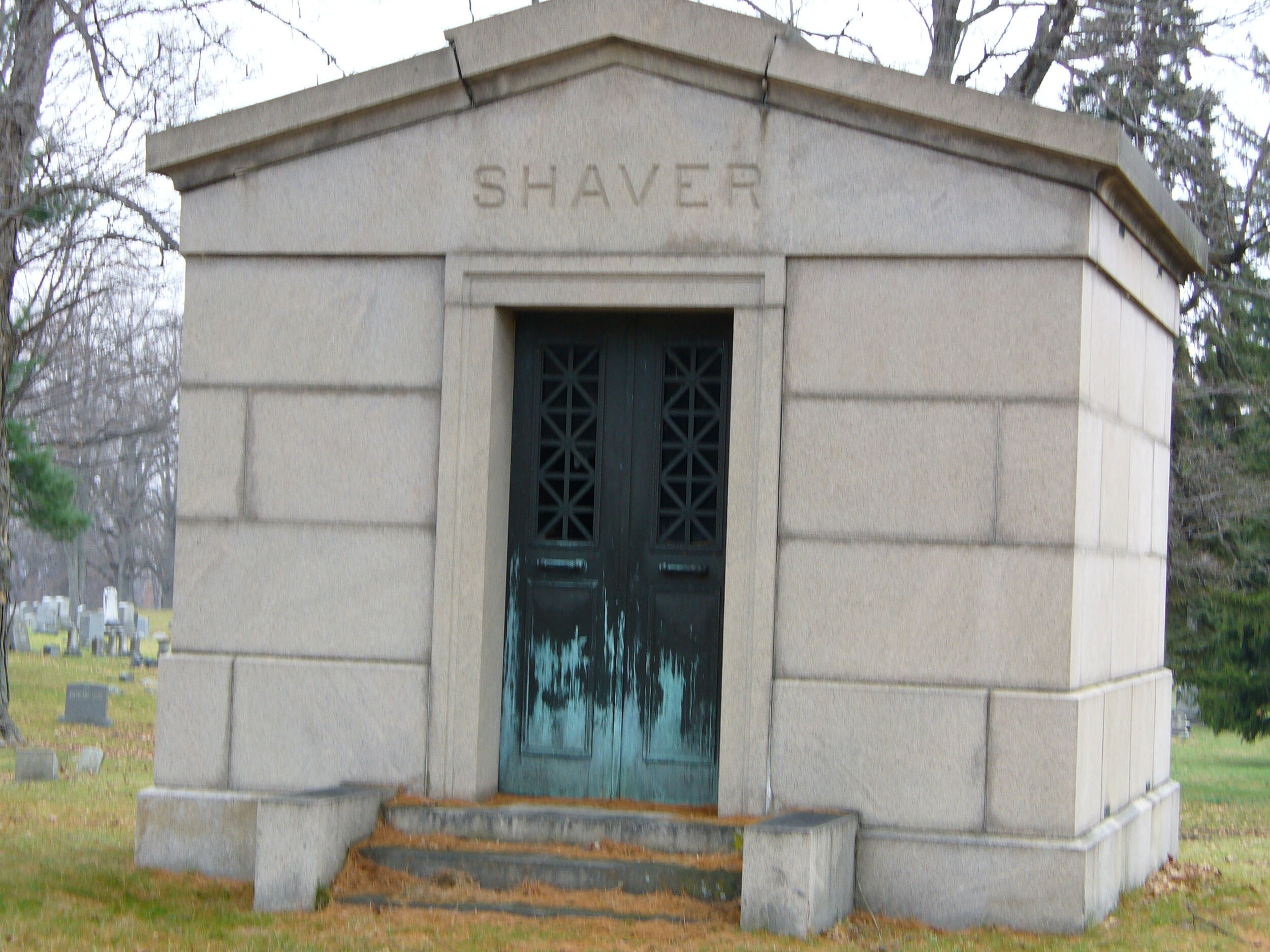
A mausoleum that features stained glass.
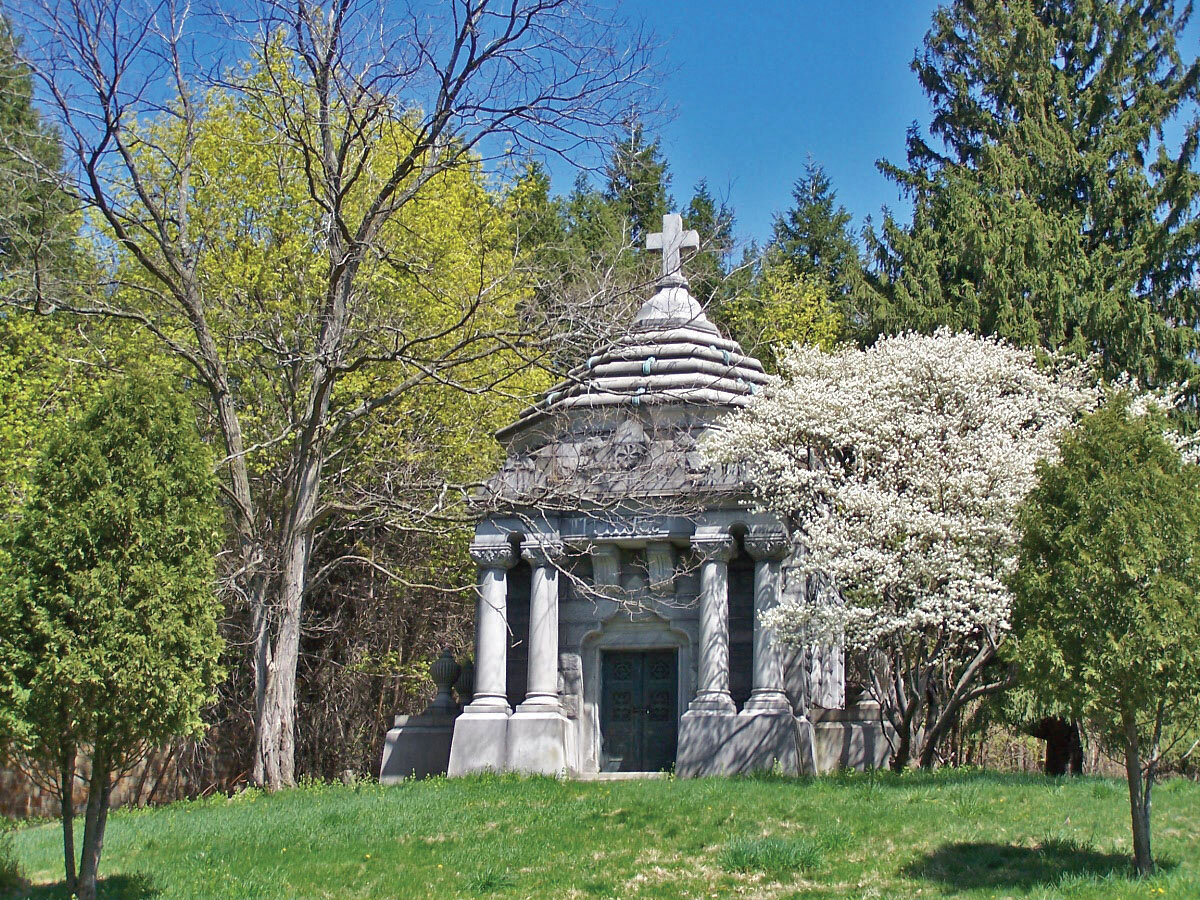
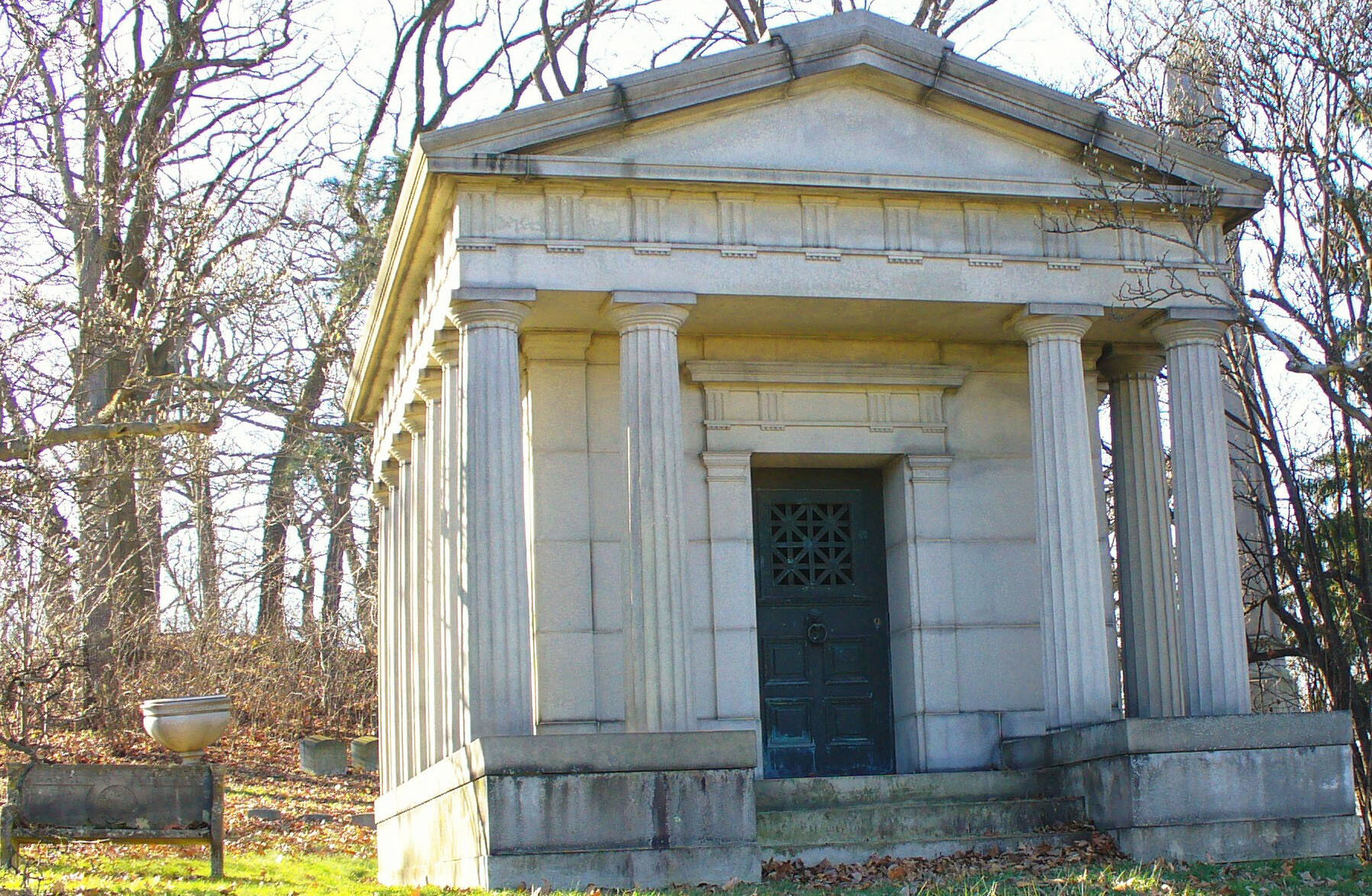
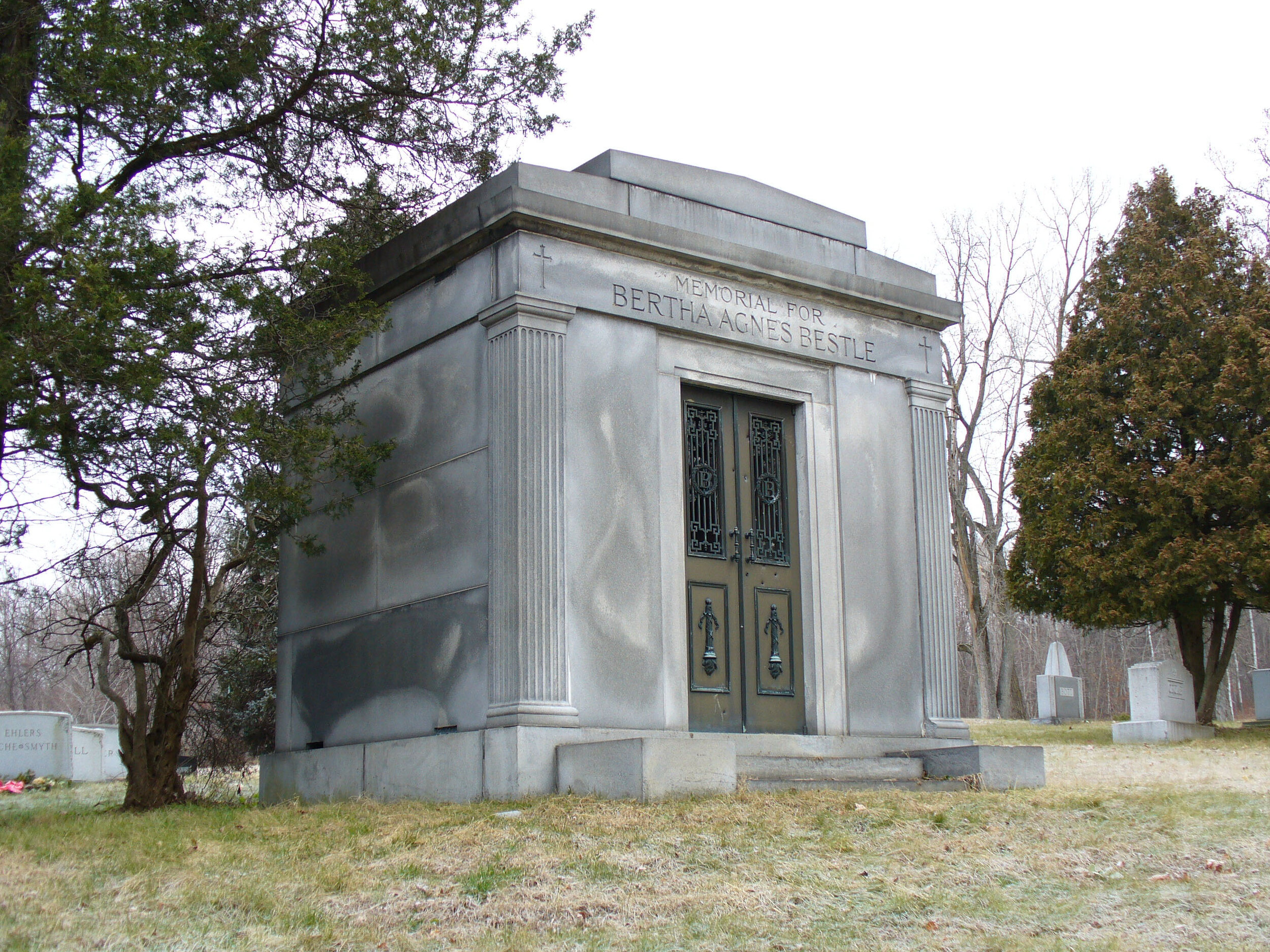
Burial place of Bertha Agnes Bestle.
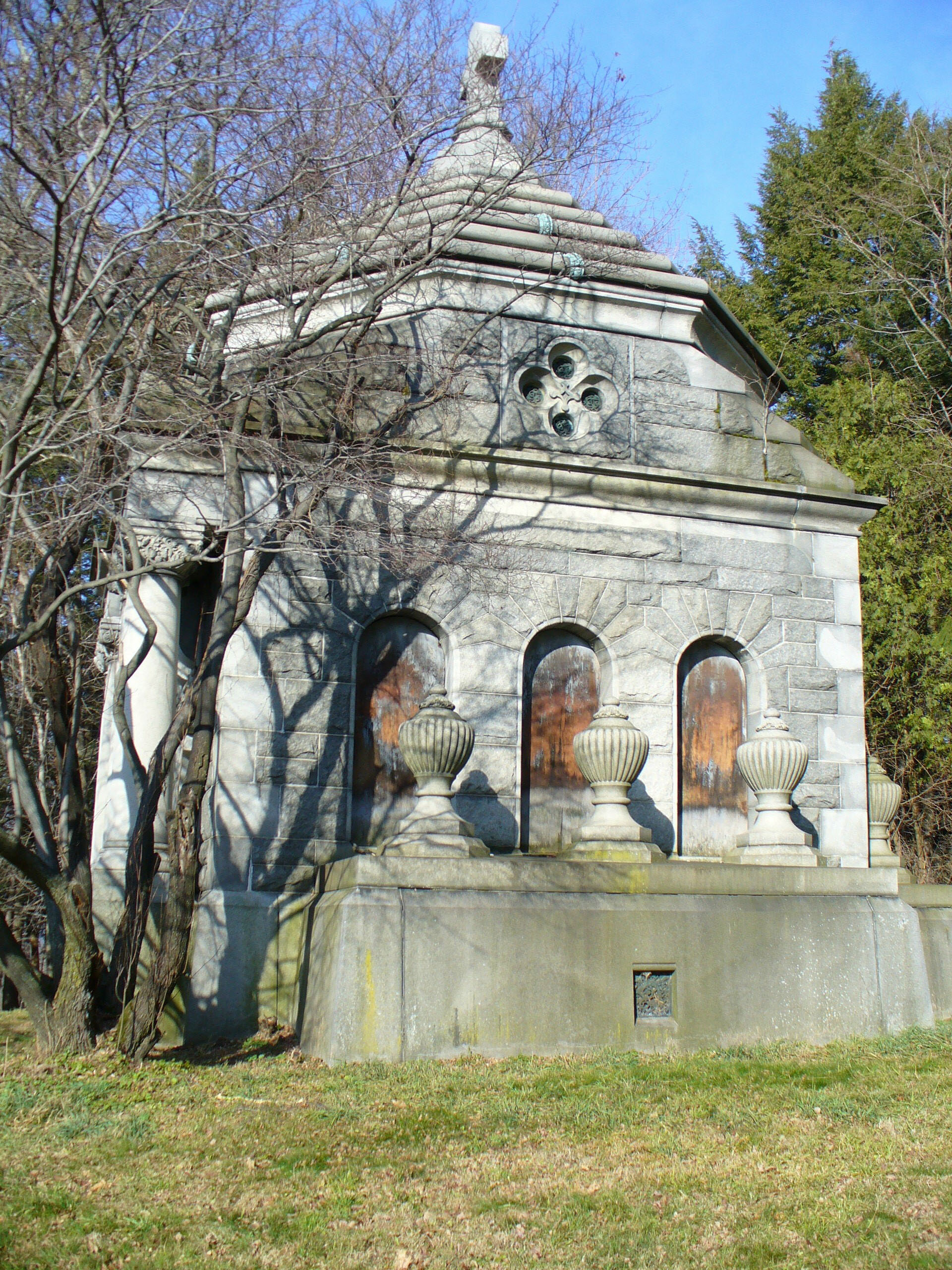
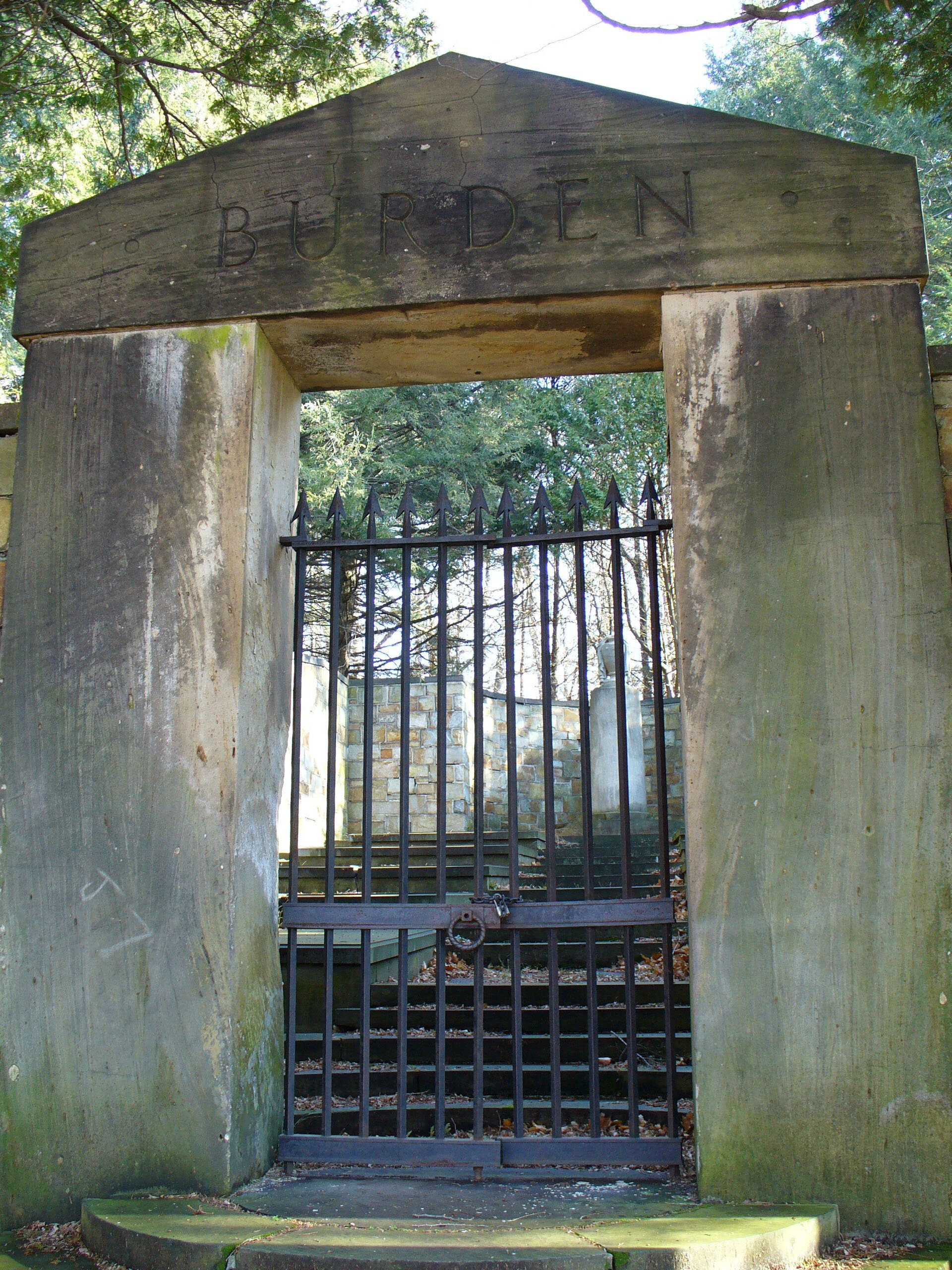
The Burden Mausoleum and Compound is quite unusual, as it is a hillside enclosed by a wall, with horizontal stones. It was designed in 1927 by Delano and Aldrich, a firm from New York City. They were well known for stately houses: “...they were among the most successful of the generation of architects who took European and classical precedent and forged a personal interpretation of house architecture during the first half of the 20th century.”
Buried within is James Abercrombie Burden, II, heir to the Burden Iron Works and his wife Florence Adele Sloan Tobin.
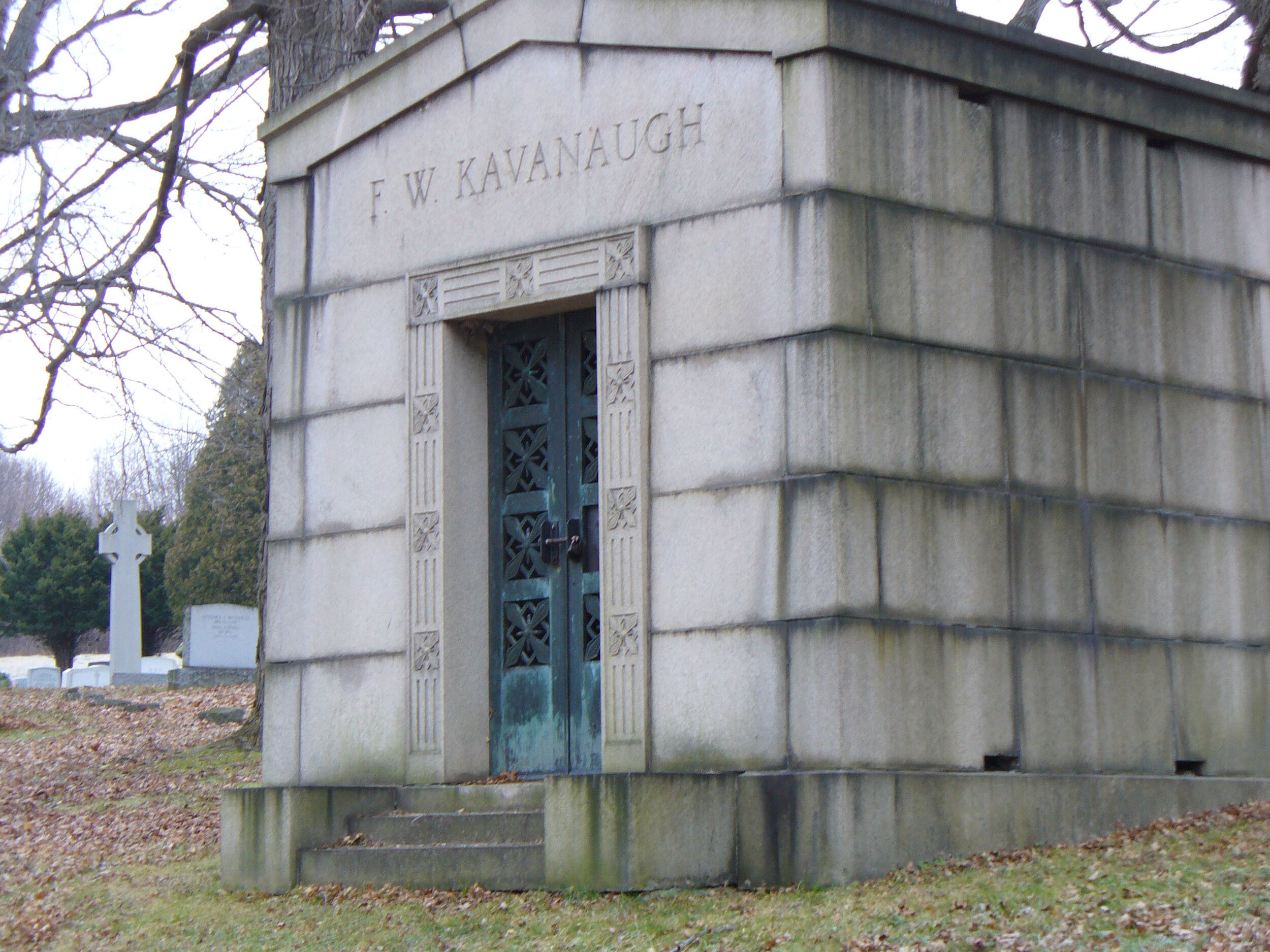
With stained glass, the mausoleum has the family name carved above the door in stone.
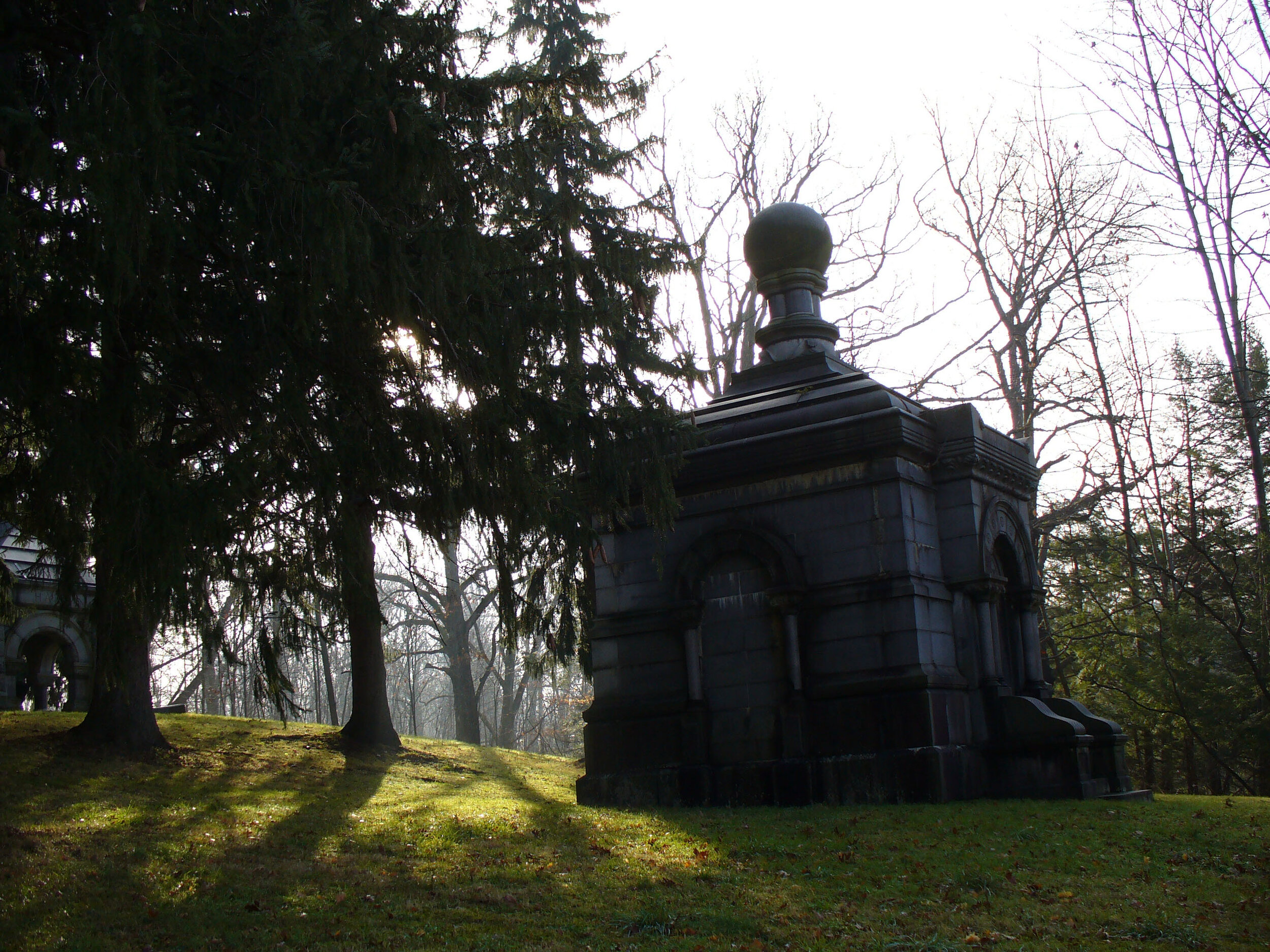
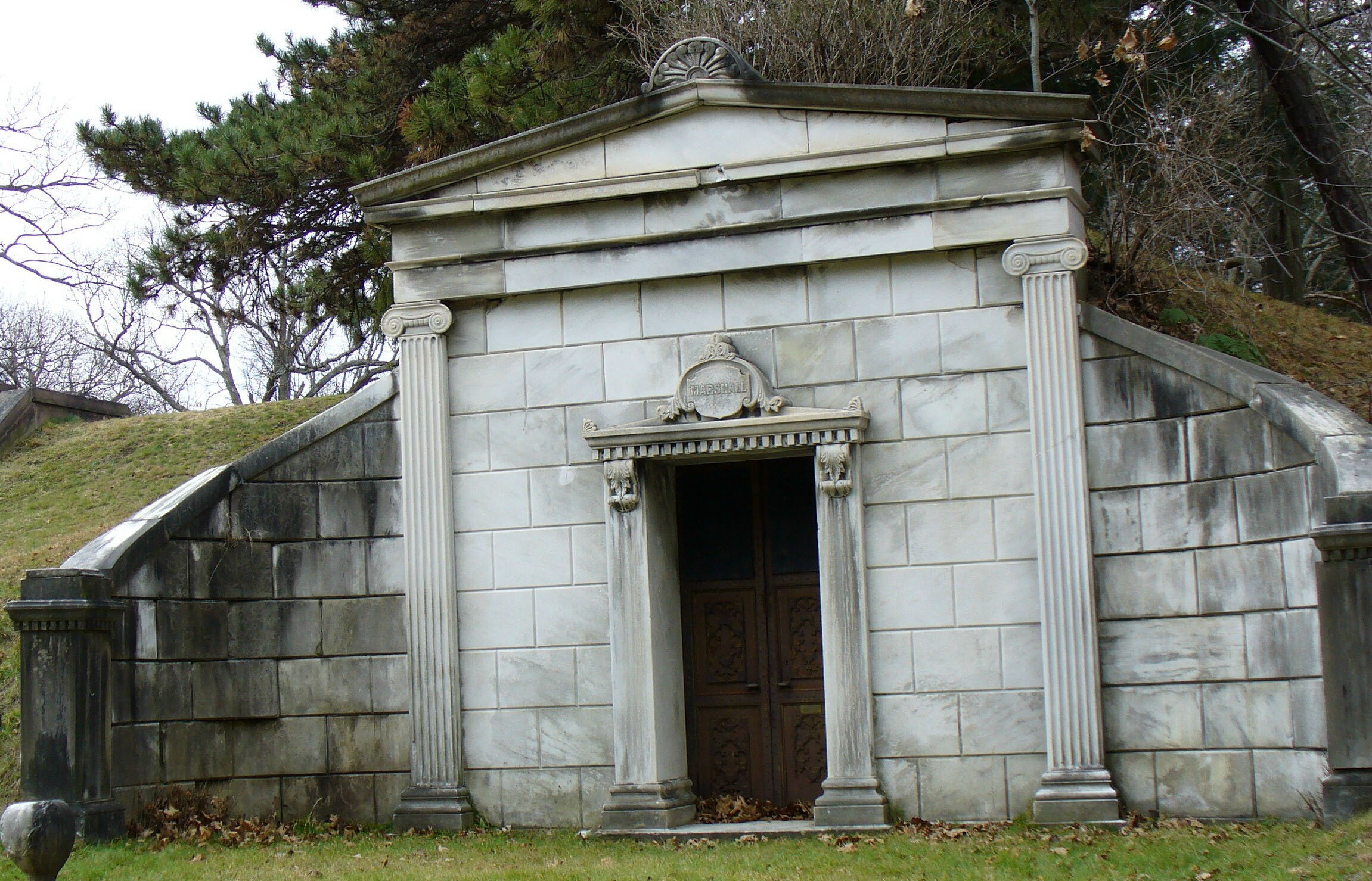
Benjamin Marshall had a cotton factory, Wool-Tex, on Congress Street. A descendant of his built the tunnel on the Poestenkill.
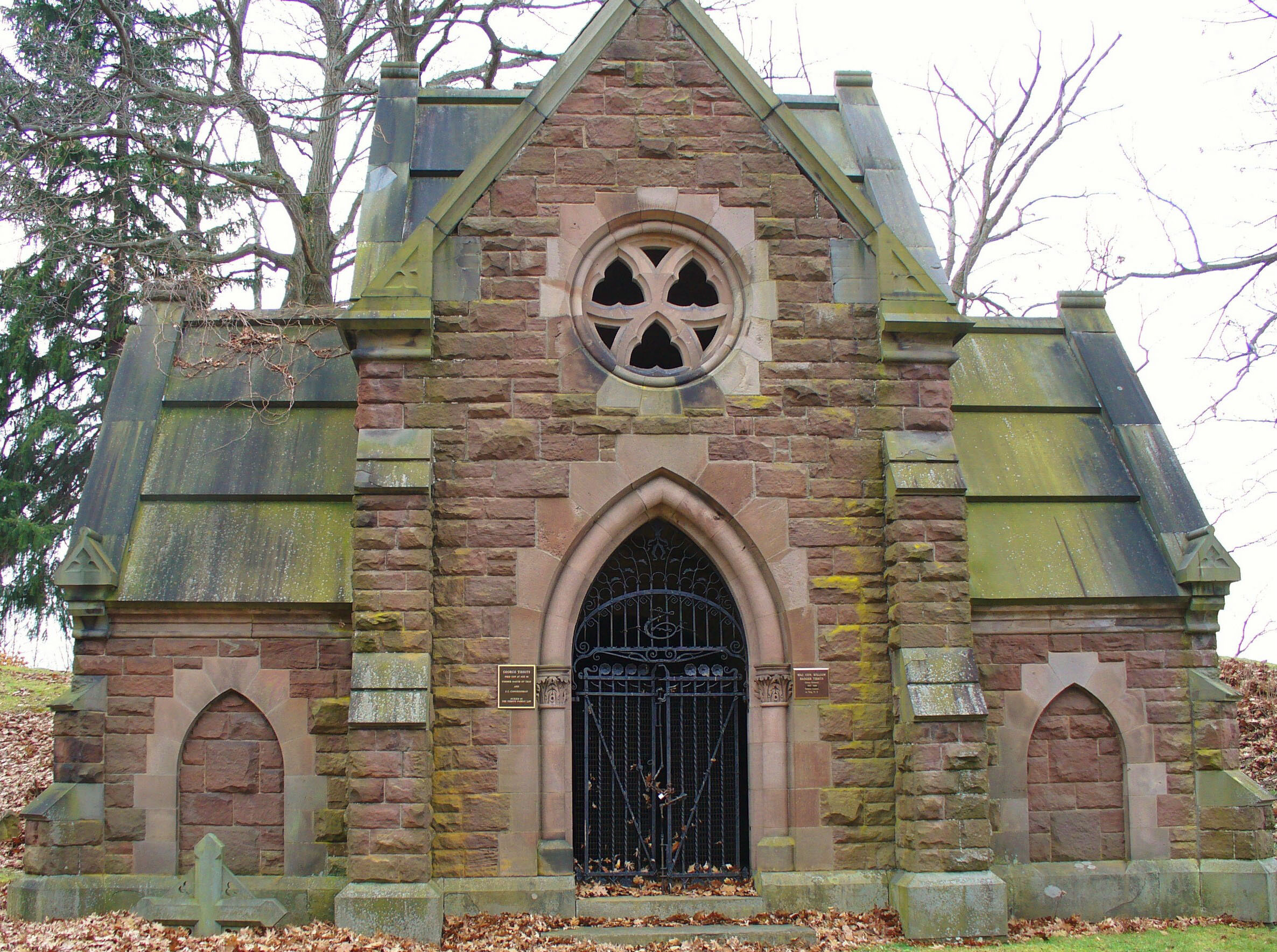
The Tibbits Mausoleum, resting place of George Tibbits, was designed in 1870 by Henry Dudley. Tibbits was a mayor of Troy and Congressman. Dudley specialized in an English Gothic Revival Ecclesiastical Style, and designed numerous Episcopal Churches in our area, such as Trinity Lansingburgh, and St. Mark’s in Hoosick Falls. Many, like this mausoleum, use a reddish rough cut or rusticated brownstone. It is believed the Tibbits grandson commissioned the mausoleum.
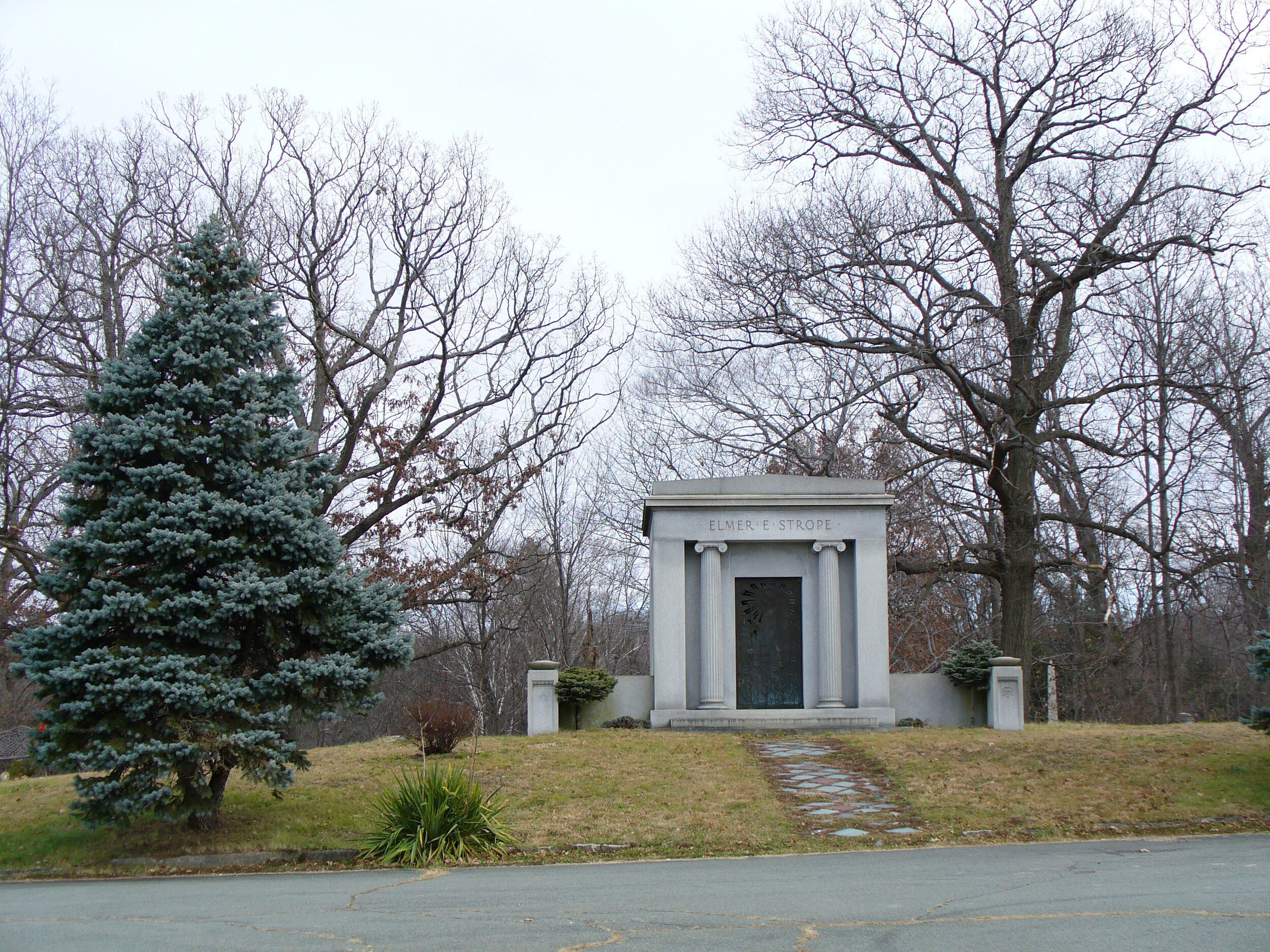
The bronze door adds distinction tom this burial place of Elmer Strope.
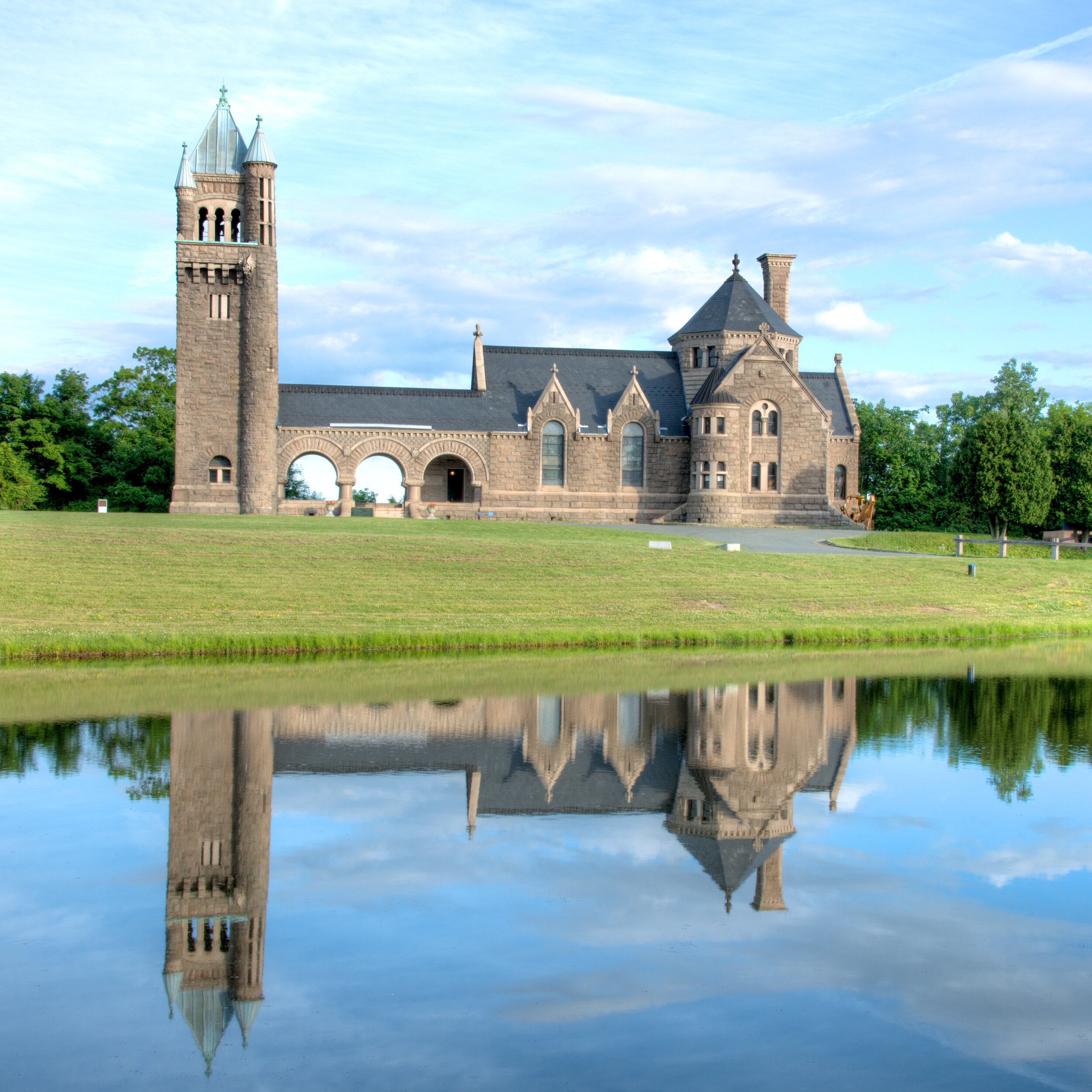
This focal point of Oakwood Cemetery celebrates the parental love of the Earls for their son who died at a young age.
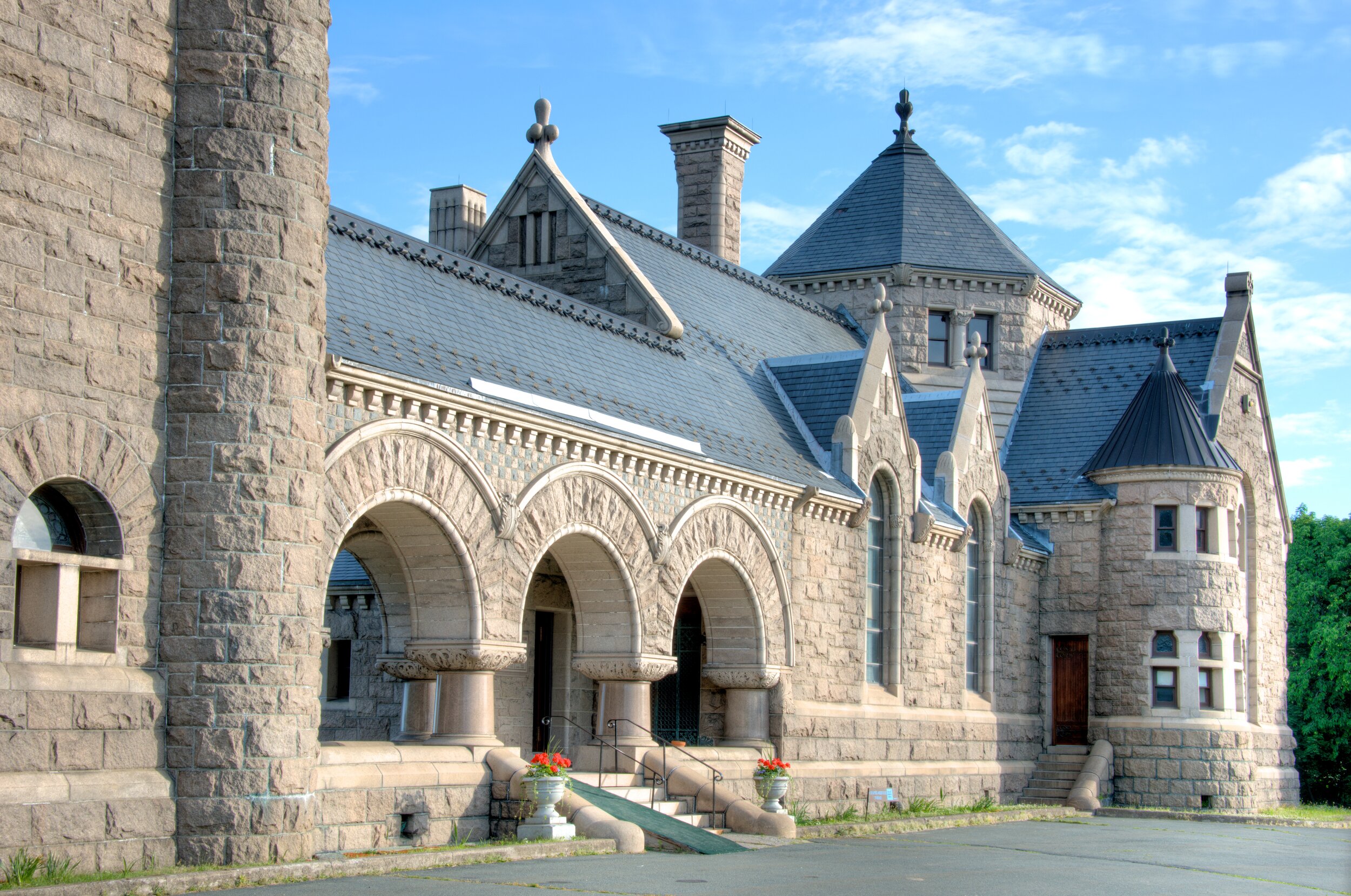
Side angle
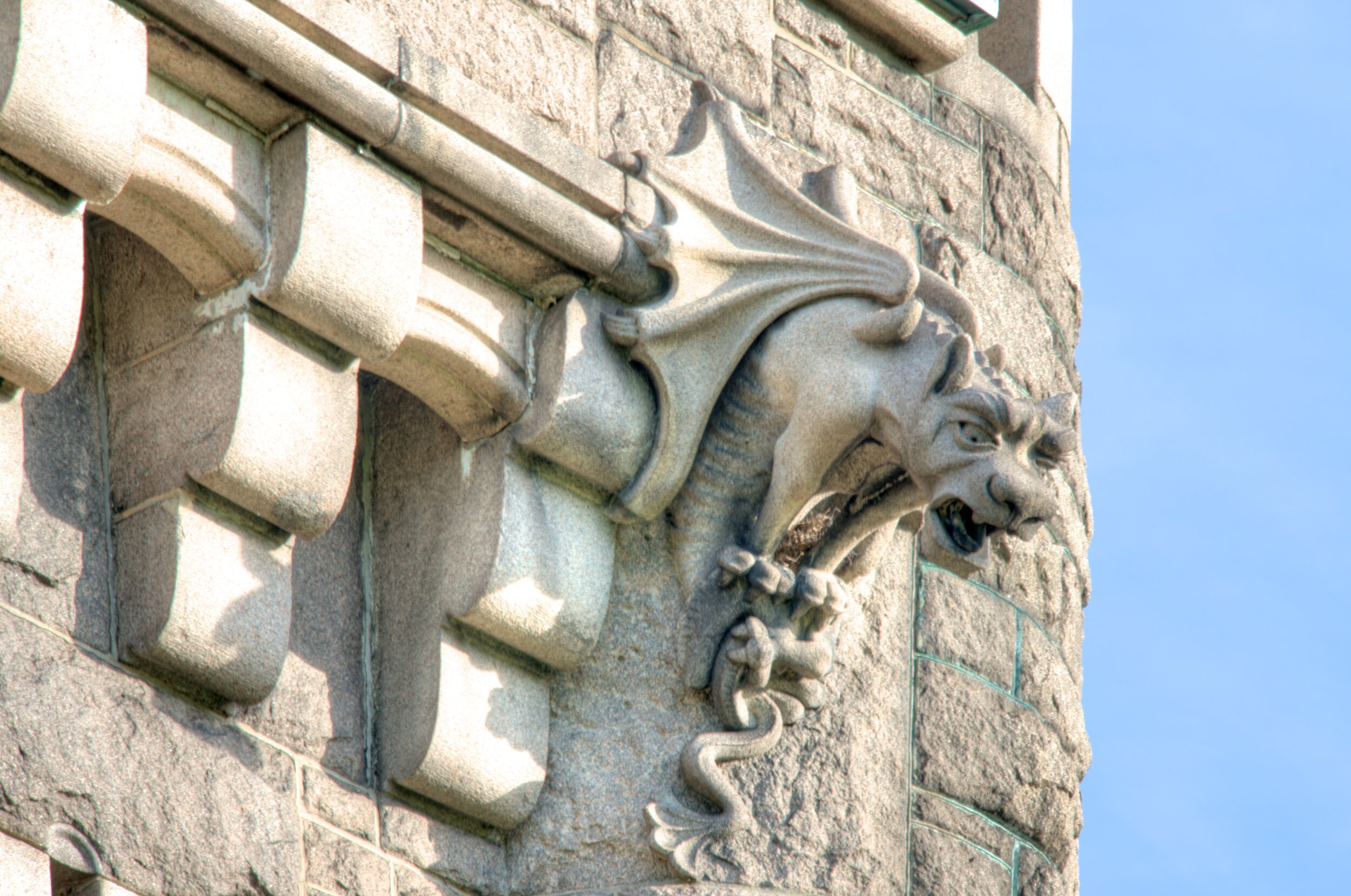
The gargoyle carved into the Chapel tower.

































